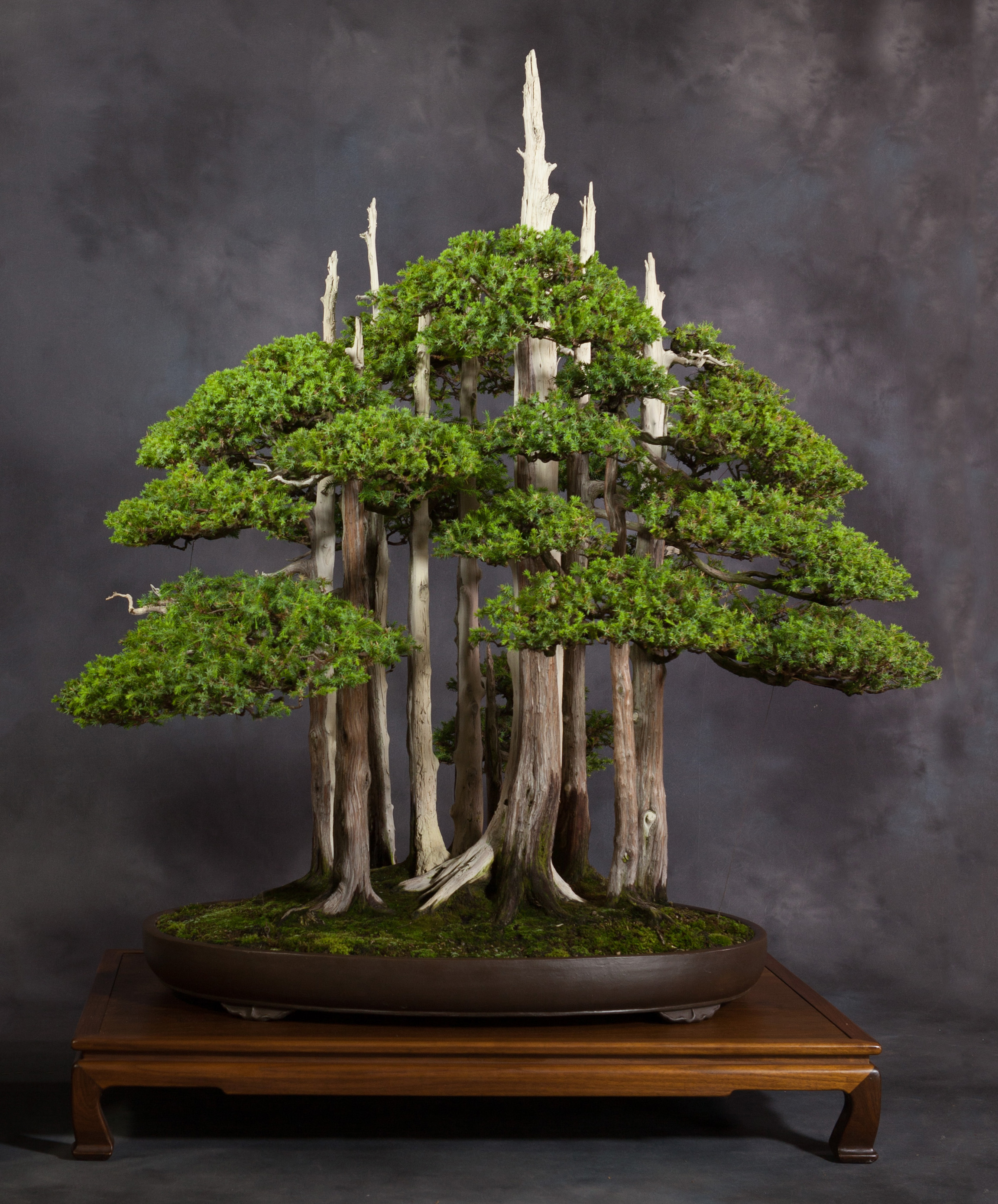
"Goshin" Chinese Juniper Forest
Juniperus chinensis
In Training Since 1953
Gift of John Yoshio Naka, 1984
This is one of the most recognized bonsai in the world. Bonsai master John Naka created his forest with 11 trees—one for each of his grandchildren—and named it Goshin, meaning "protector of the spirit."
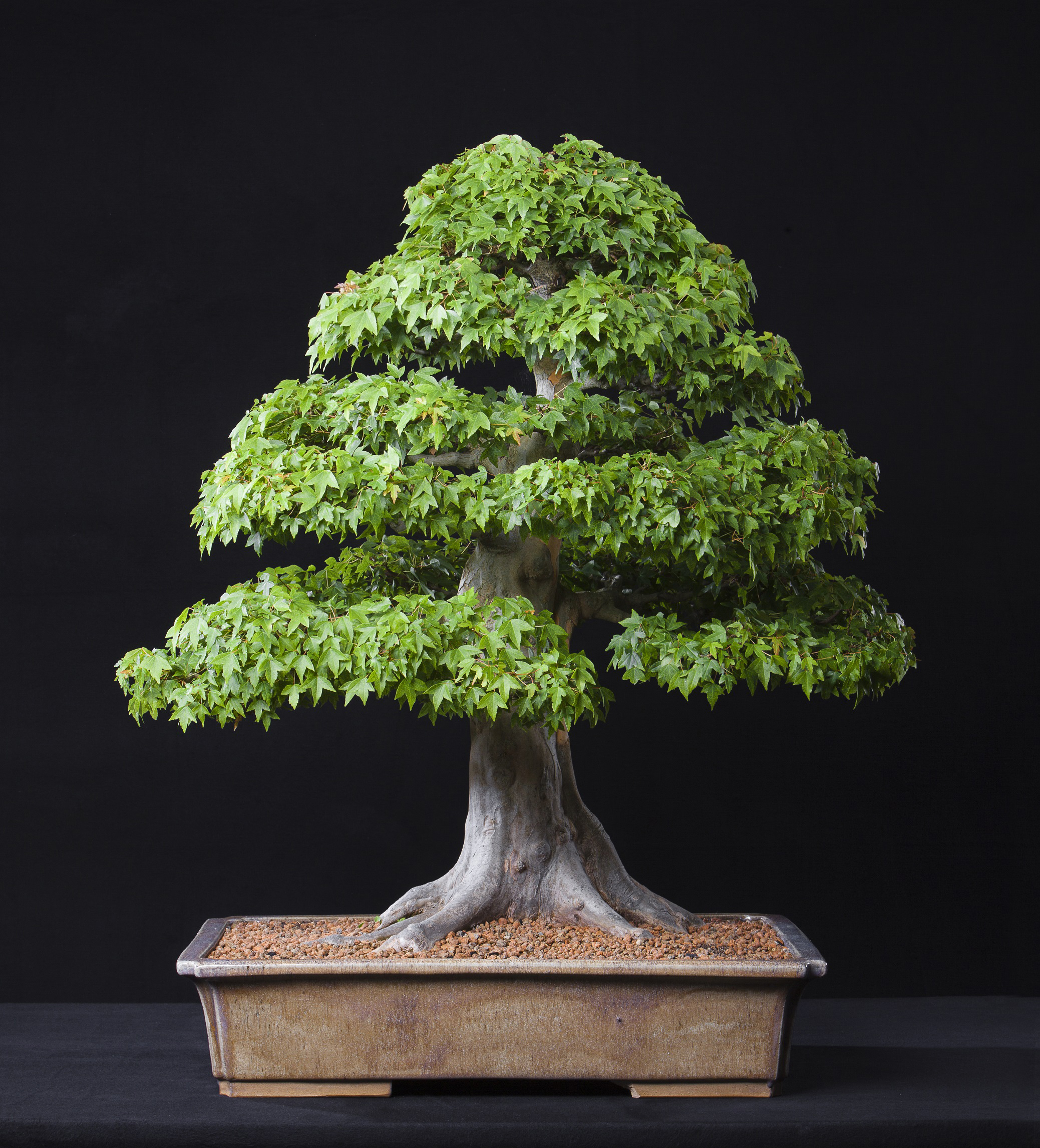
Trident Maple
Acer buergerianum
In training since 1975
Gift of Ted C. Guyger, 1990
Bonsai created from trees collected from the outdoors start out with a thicker, more mature trunk. Before it was pruned, this bonsai was a 23-foot tall tree.
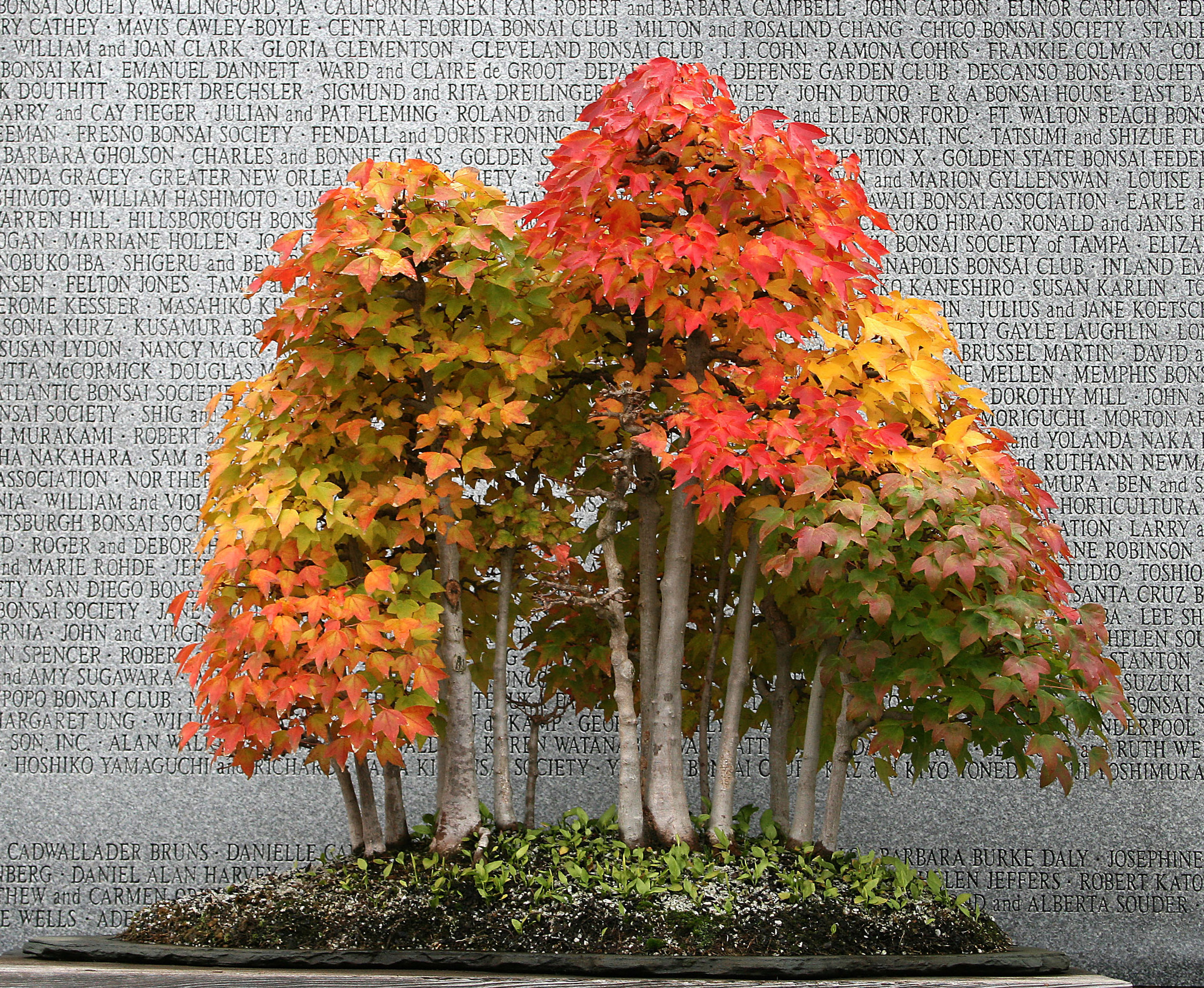
Trident Maple
Acer buergerianum
In training since 1985
Gift of Brussel Martin, 1990
Forest-style bonsai are often planted on a rock slab with the soil held in place by moss. This creates a natural-looking hillock setting.
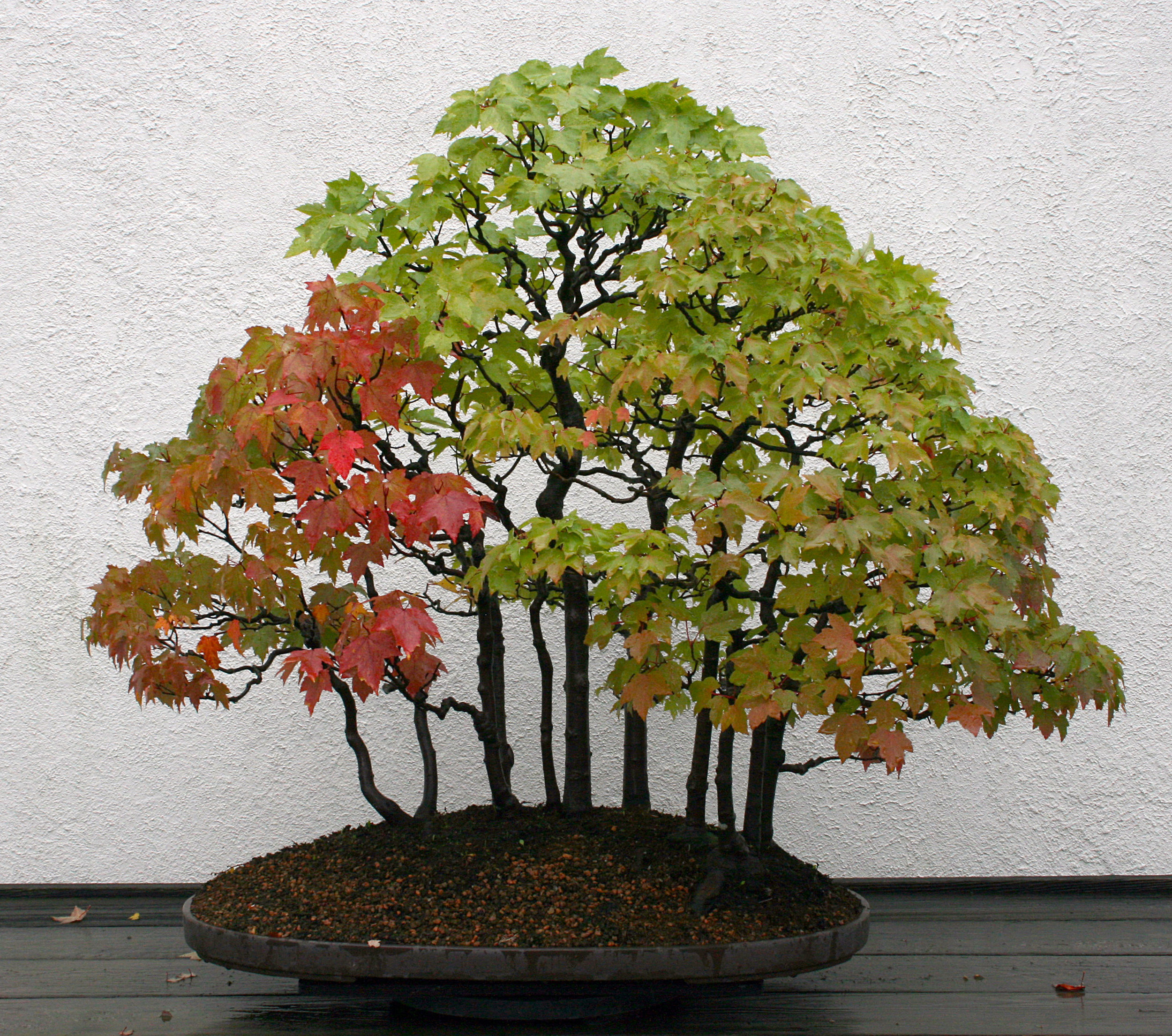
Drummond's Red Maple
Acer rubrum var. drummondii
In training since 1974
Gift of Vaughn L. Banting, 1990

Bougainvillea
Bougainvillea glabra
In training since 1985
Gift of Harold M. Harvey, 1990
Even though bougainvillea is a vine, it can be grown as a bonsai by continually pruning the long growth.
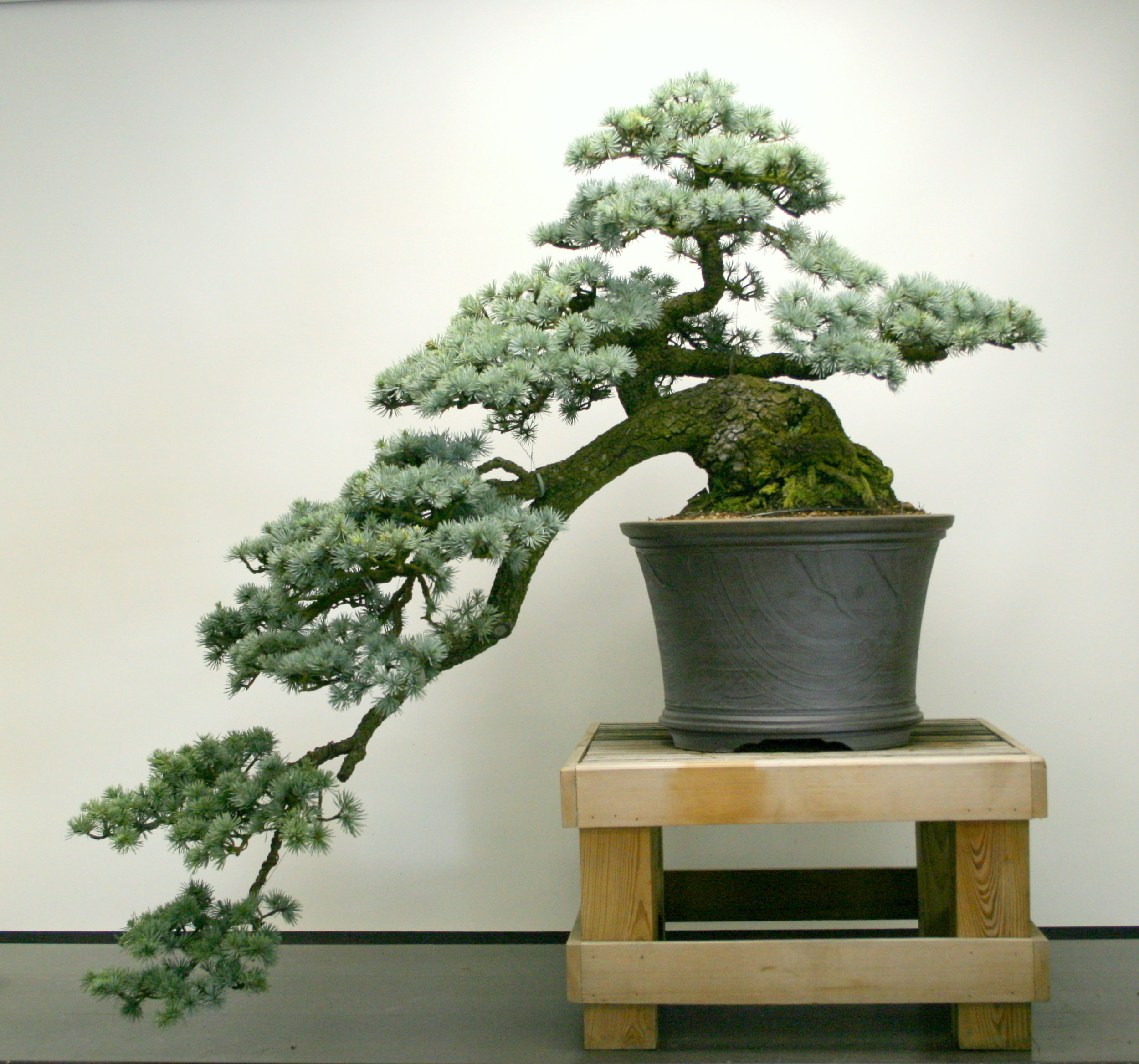
Blue Atlas Cedar
Cedrus atlantica Glauca Group
In training since 1960
Gift of Fred & Ernesta Ballard, 1990
This bonsai is trained in the cascade style, in which the tree is trained to imitate those growing from the side of a cliff. Instead of growing upward toward the sun, the trunk and branches are pulled downward by gravity.

Blue Atlas Cedar
Cedrus atlantica Glauca Group
In training since 1948
Gift of John Yoshio Naka, 1990
One reason John Naka named this bonsai Gimpo, "Silver Phoenix," was because like the mythical bird rising from ashes, even the ugliest tree can become a majestic bonsai in the hands of a master.
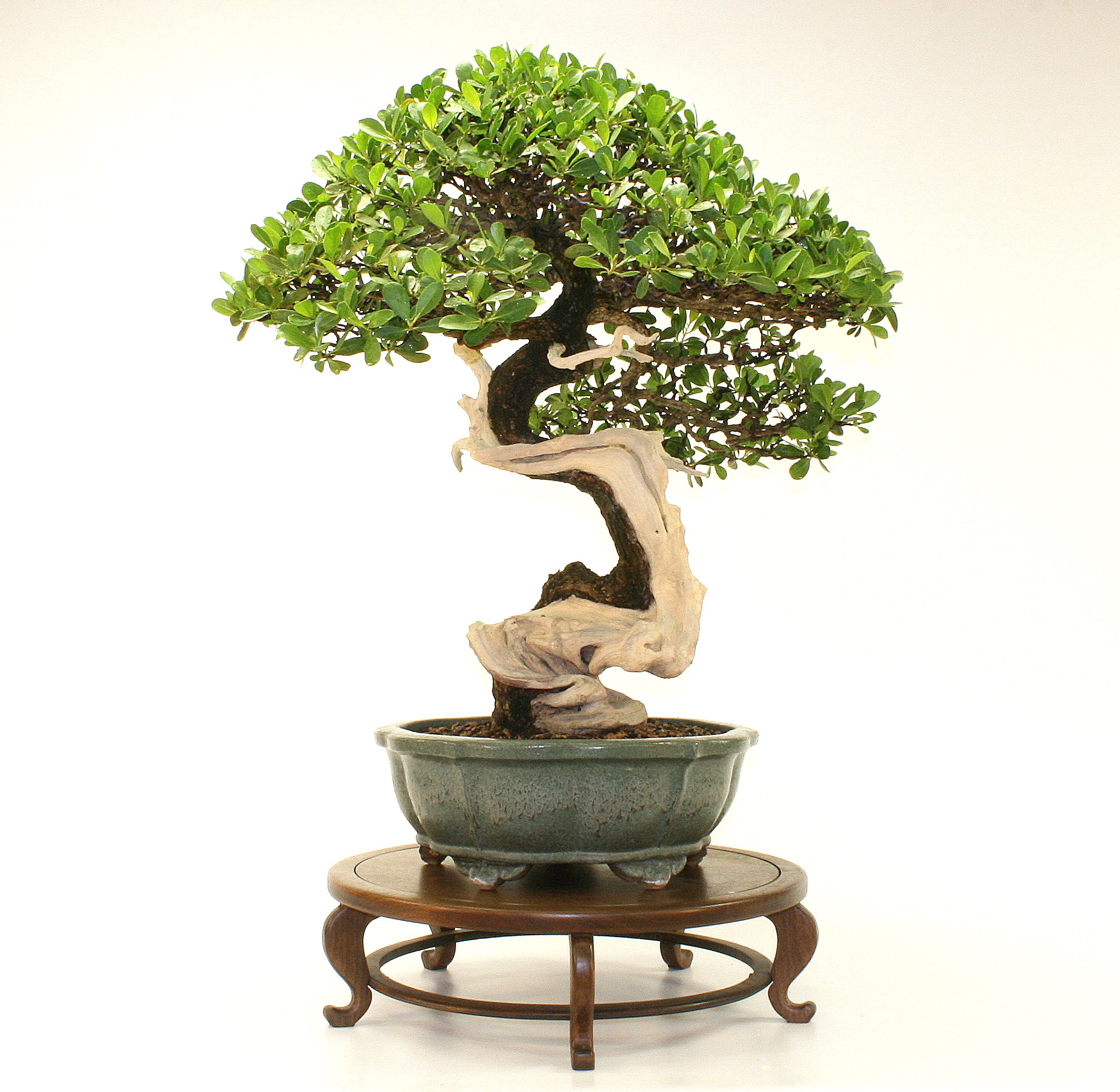
Buttonwood
Conocarpus erectus
In training since 1975
Gift of Mary Madison, 1990
Buttonwood is a native American species from the swamps of Florida. Its naturally twisted trunks make it popular material for tropical bonsai.
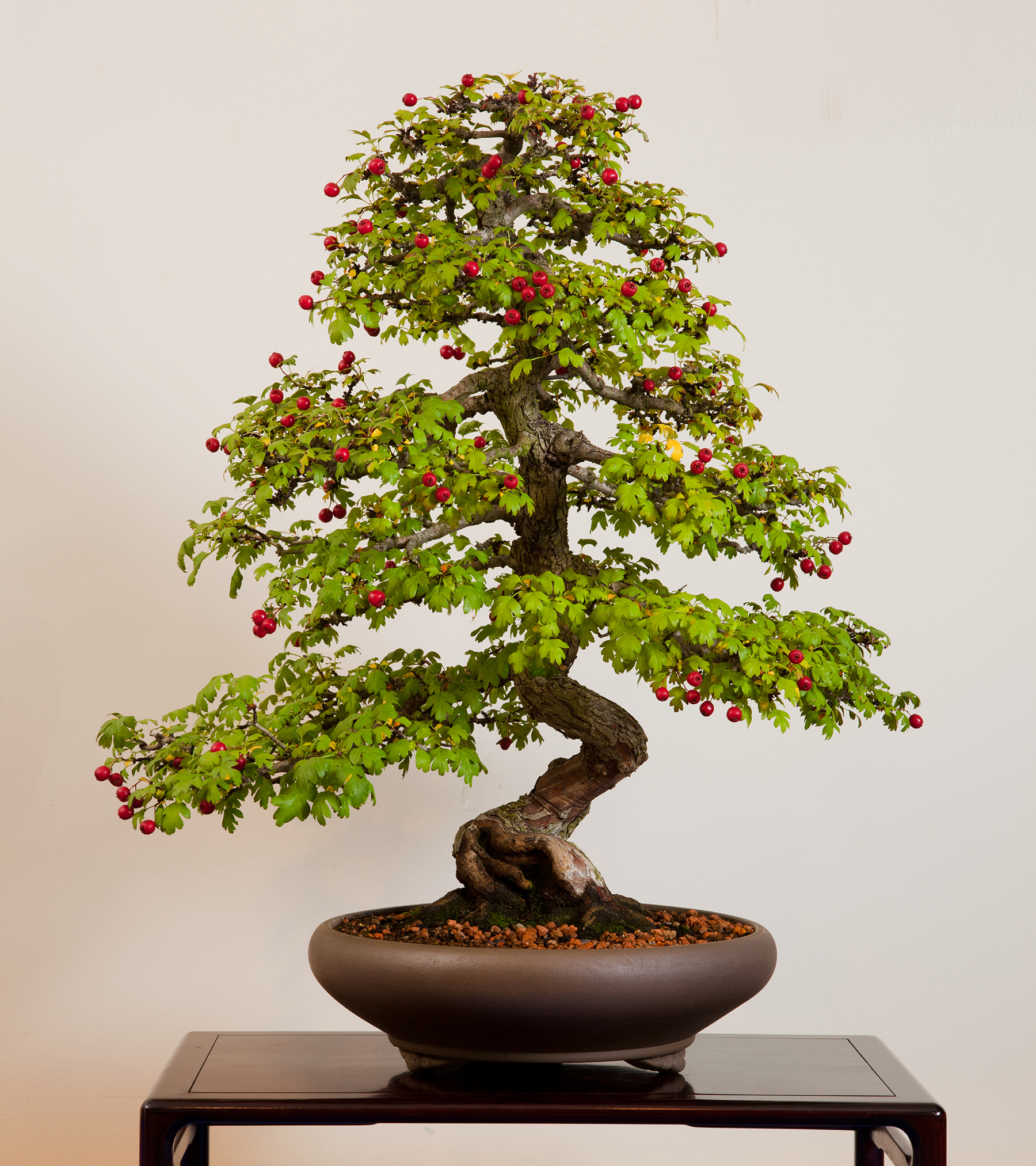
English Hawthorn
Crataegus laevigata
In training since 1955
Gift of Bertram F. Bruenner, 1990
The artist created the unique twisting trunk on this bonsai by shaping it with wire when it was still a seedling and very pliant. Once the tree matured, the wire could be removed.
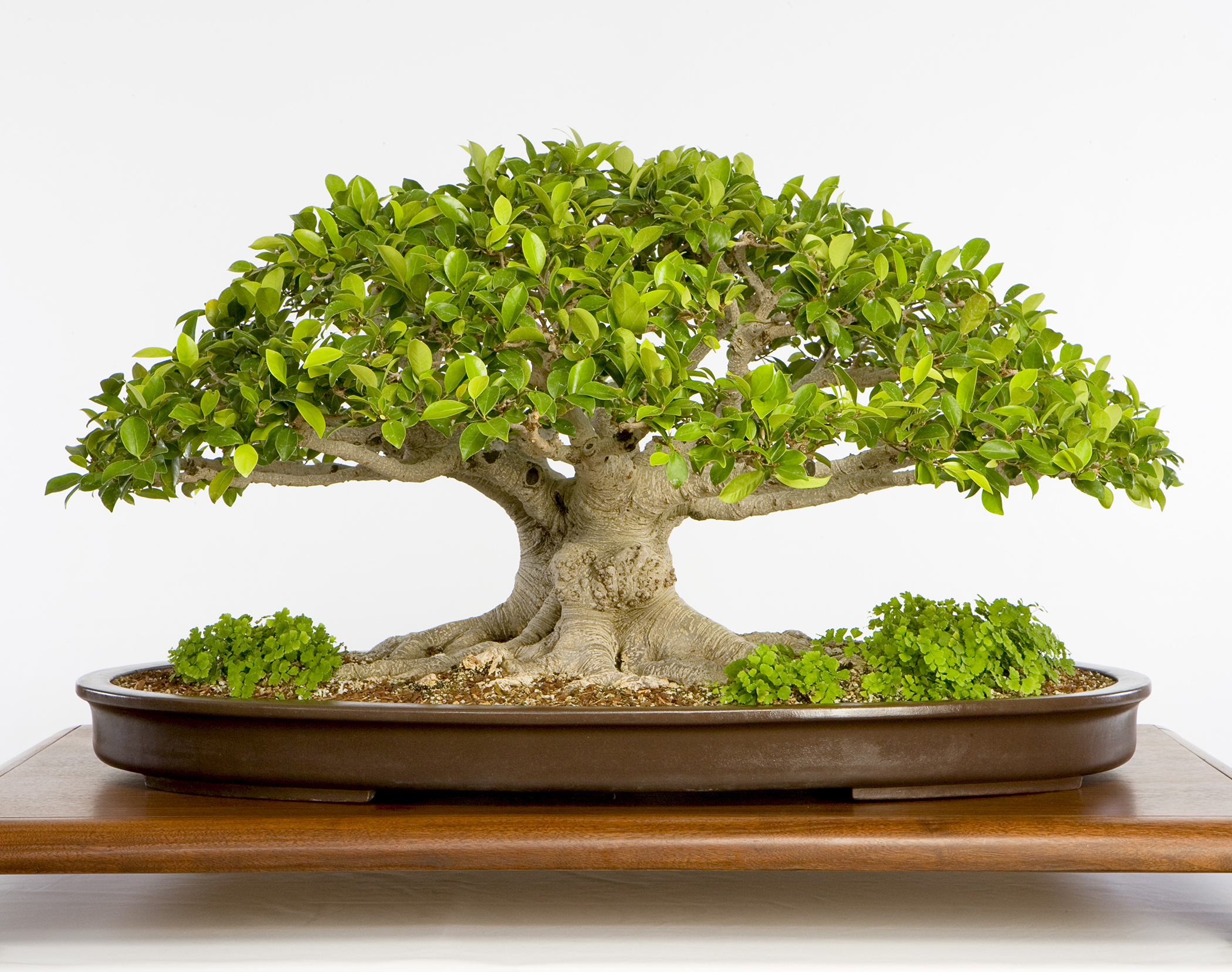
Chinese Banyan
Ficus microcarpa
In training since 1971
Gift of Mike Uyeno, 1990
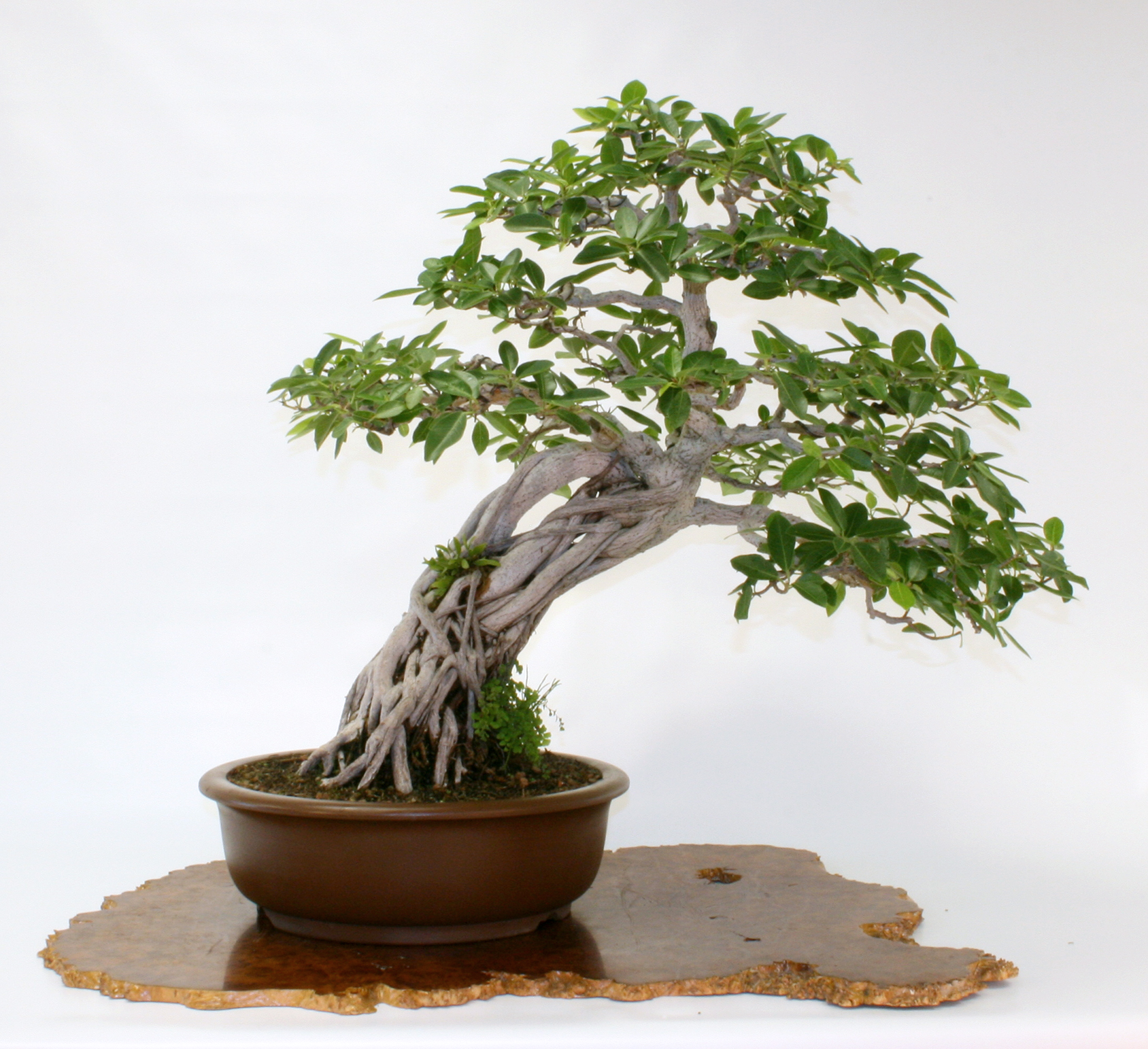
Natal Fig
Ficus natalensis
In training since 1976
Gift of David W. Fukumoto, 1990
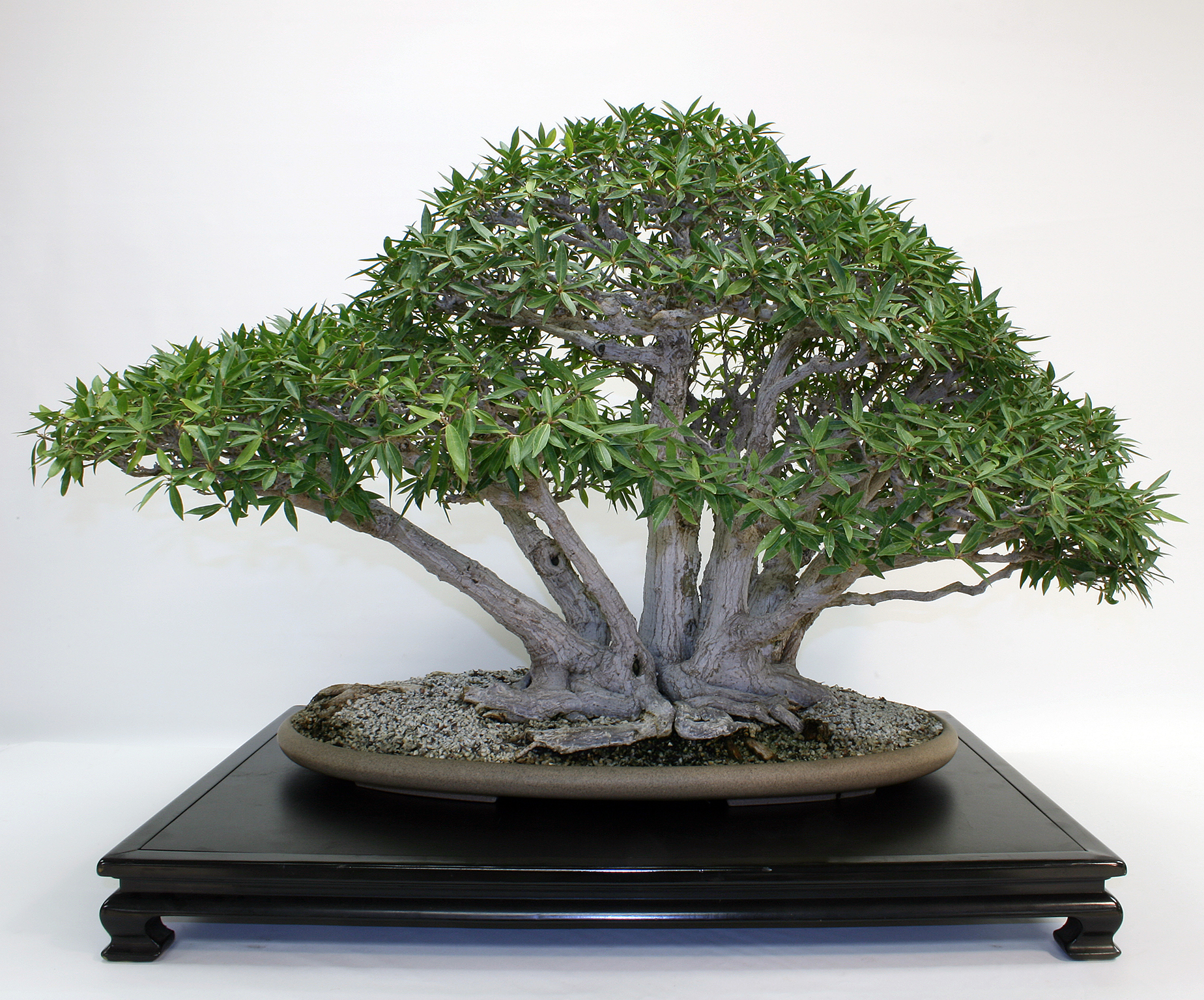
Willow-leaf Ficus
Ficus salicaria
In training since 1974
Gift of Helen C. Souder, 1990
Clump style bonsai are trees that have multiple trunks emanating from a single base. Ficus make good trees for bonsai beginners because they grow quickly.
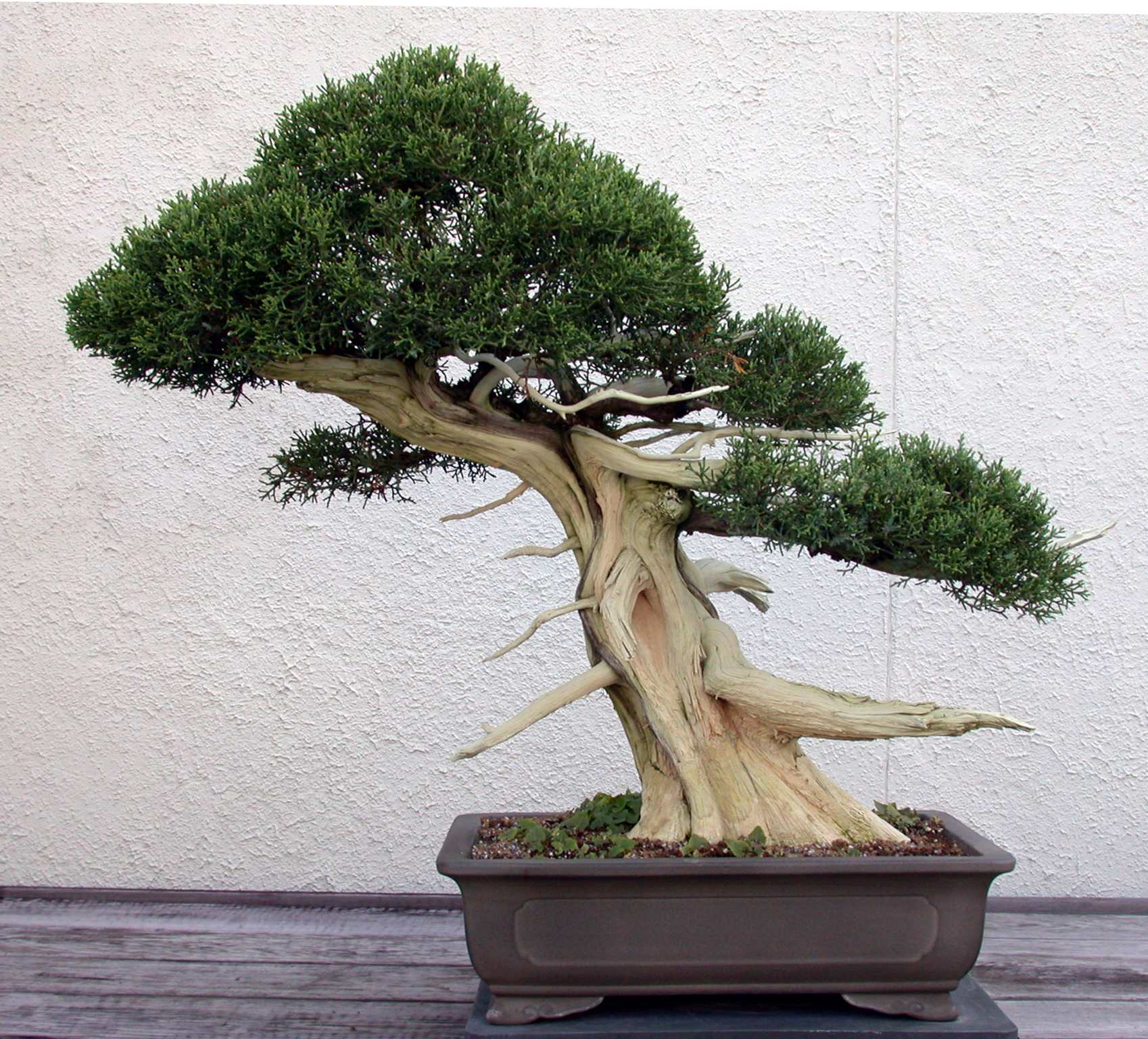
California Juniper
Juniperus californica
In training since 1967
Gift of Kiichi Wayne Takayasu, 1990
This native juniper from the mountains in California is one of the most popular trees to collect for bonsai. California junipers grow slowly, usually over hundreds of years, and have interesting deadwood.
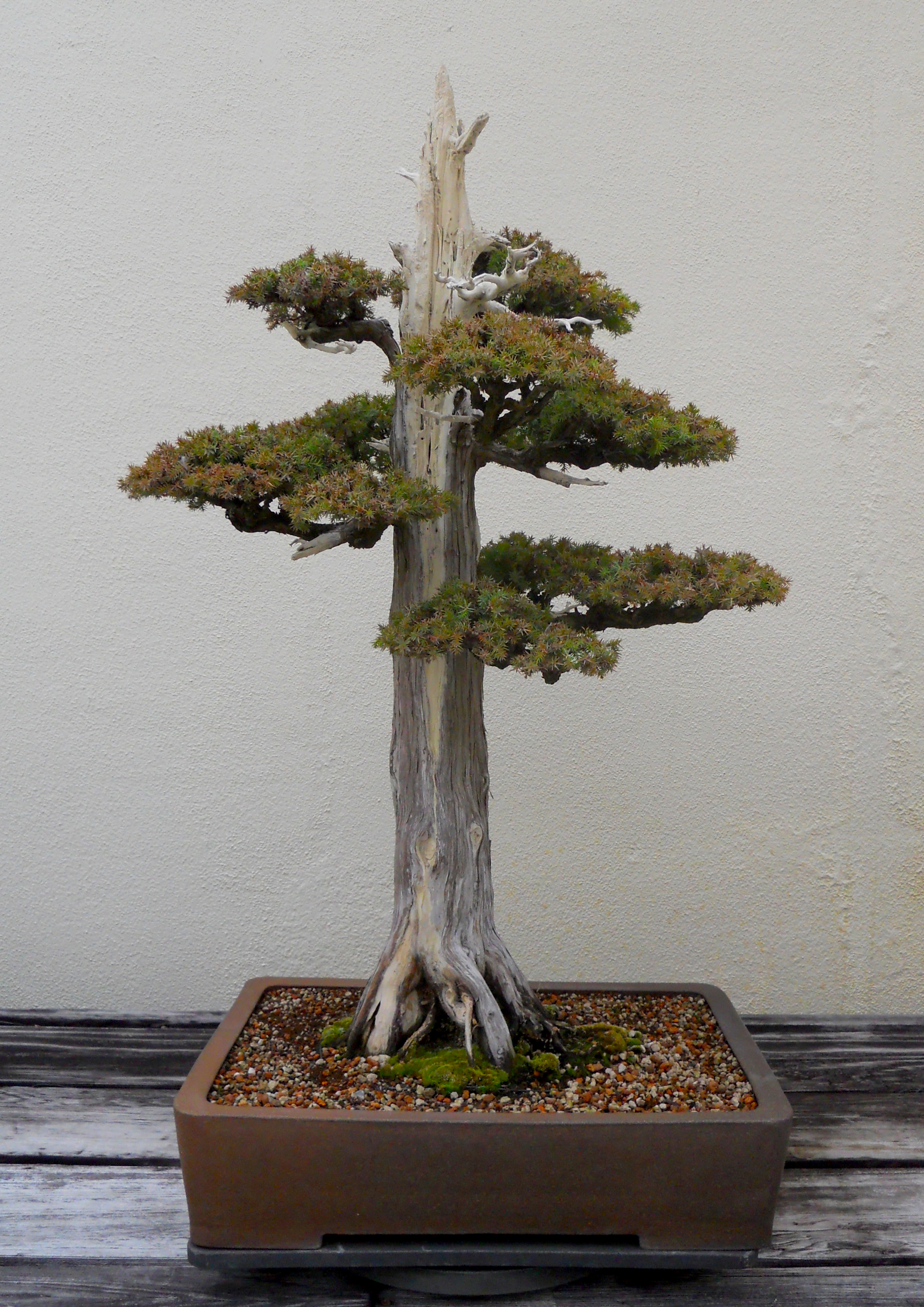
Chinese Juniper
Juniperus chinensis 'Femina'
In training since 1975
Gift of James & Helen Barrett, 1990
This tree has been styled to look like a lone tree hit by lightening, causing the top to die. It was a style made popular by the famous American bonsai master John Naka.
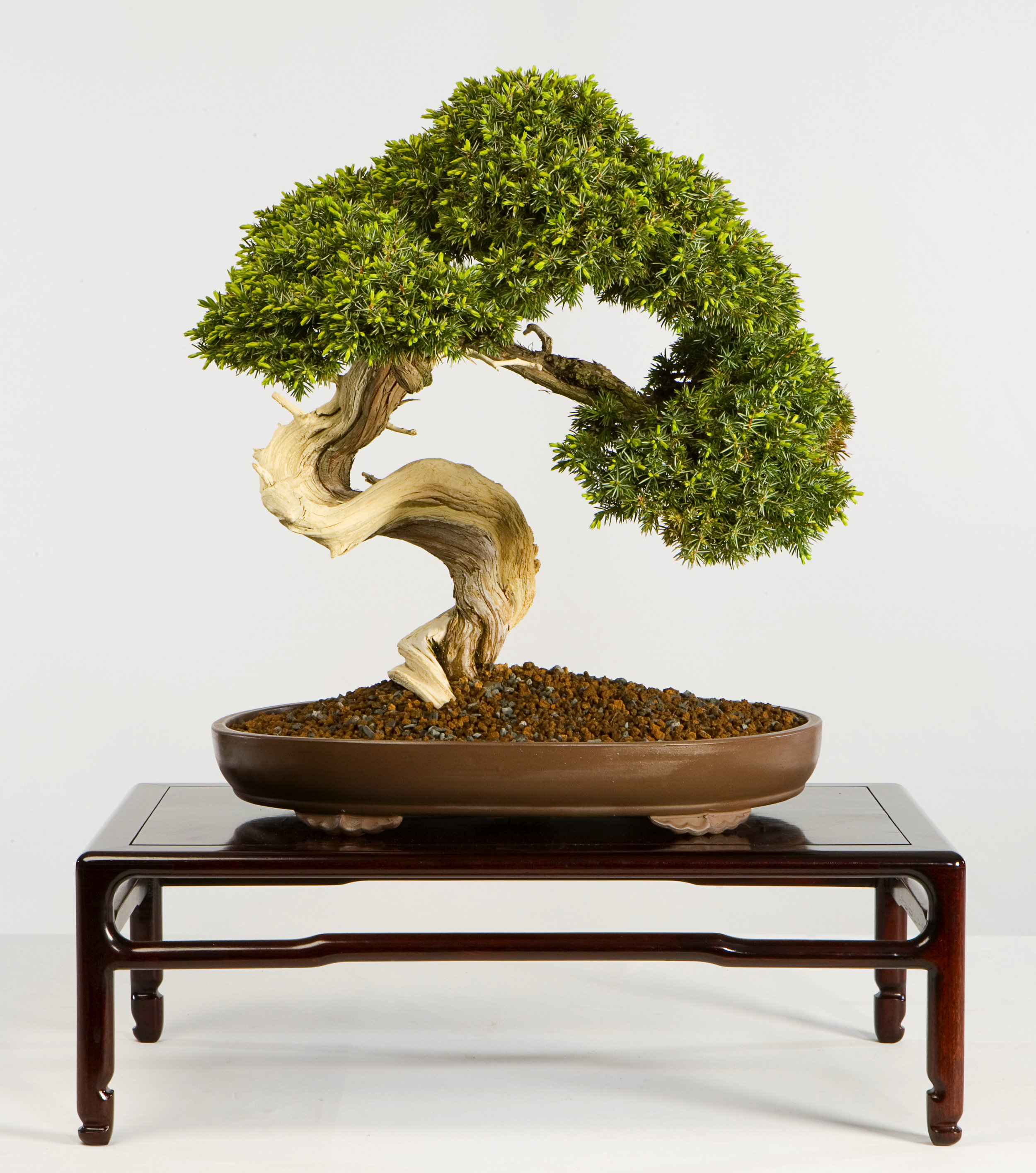
Pasture Juniper
Juniperus communis var. depressa
In training since 1980
Gift of Jack B. Douthitt, 1990

Japanese Garden Juniper
Juniperus procumbens 'Nana'
In training since 1975
Gift of Thomas Tecza, 1990
This dwarf type of juniper came to the United States from England about 1900 for use in gardens; however, its small size soon made it a popular choice for beginner bonsai classes.
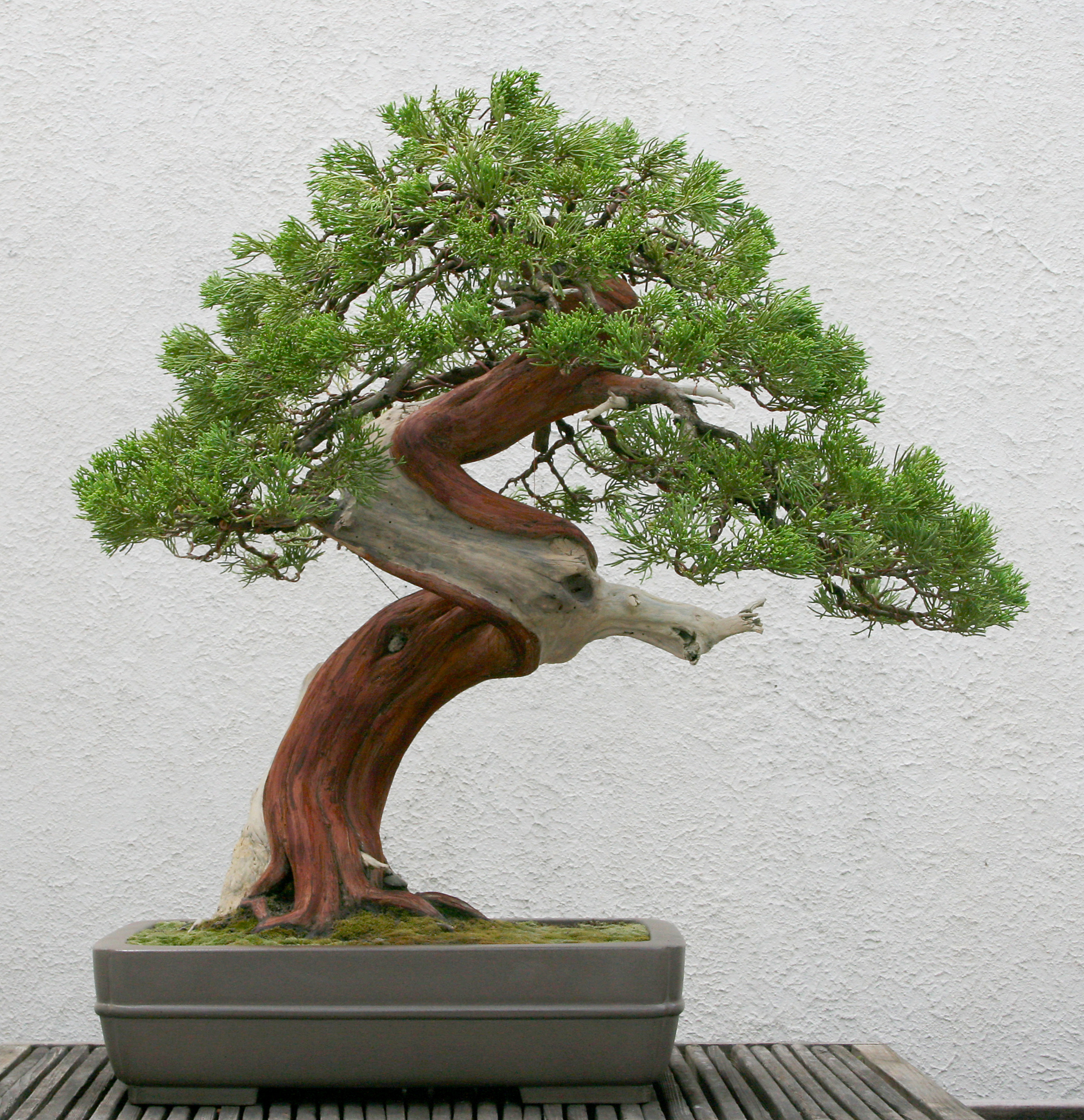
Prostrate Juniper
Juniperus horizotalis 'Prostrata'
In training since 1969
Gift of Kaz & Kiyo Yoneda, 1990
The bonsai artists created the deadwood on this nursery tree in order to make it look like an old juniper collected from the mountains.

Crapemyrtle
Lagerstroemia indica
In training since 1930
Gift of Yuji Yoshimura, 1990
This tree was started in Japan from a cutting by Yuji’s father, Toshiji Yoshimura.
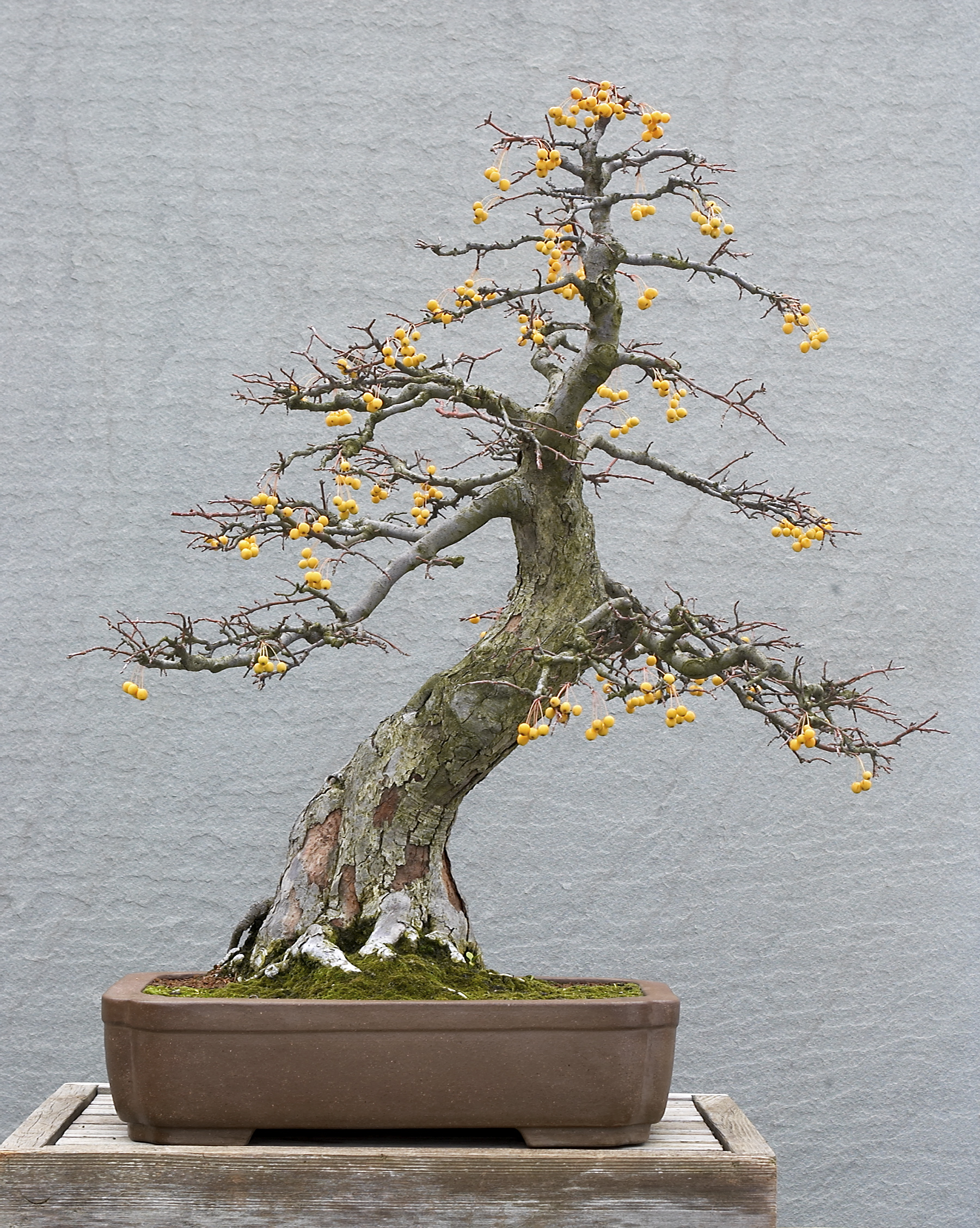
Crabapple
Malus sp.
In training since 1978
Gift of Richard Meszler, 1990
Bonsai artists prefer crabapples over regular apple trees because their smaller fruits are more in keeping with the scale of a bonsai tree.
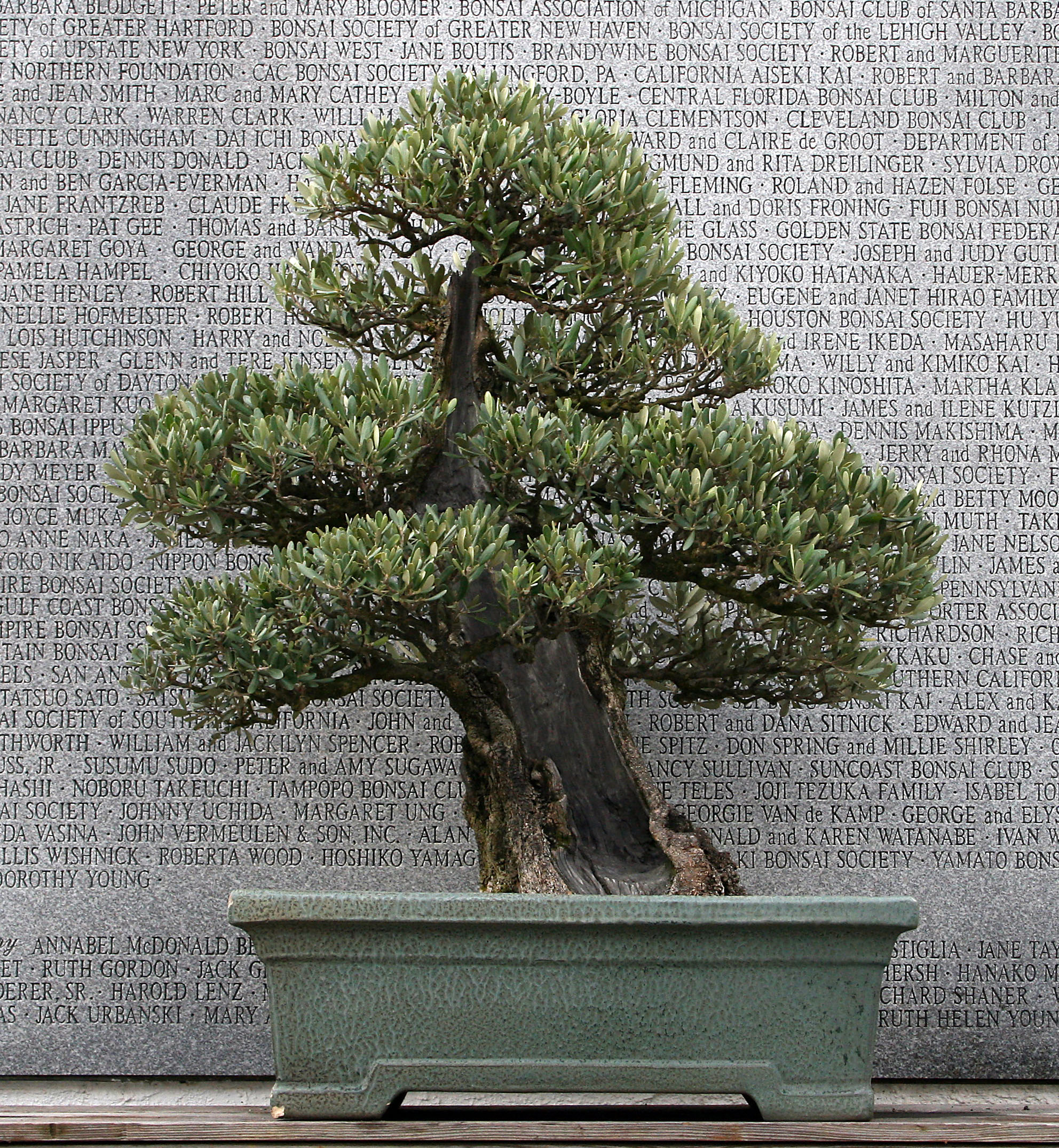
Olive
Olea europaea
In training since 1963
Gift of Melba Tucker, 1990
Originally created from a 20-foot tree, this bonsai achieves the look of great age in part through the hollowed out trunk, which in nature usually indicates that the tree has lived a long time.
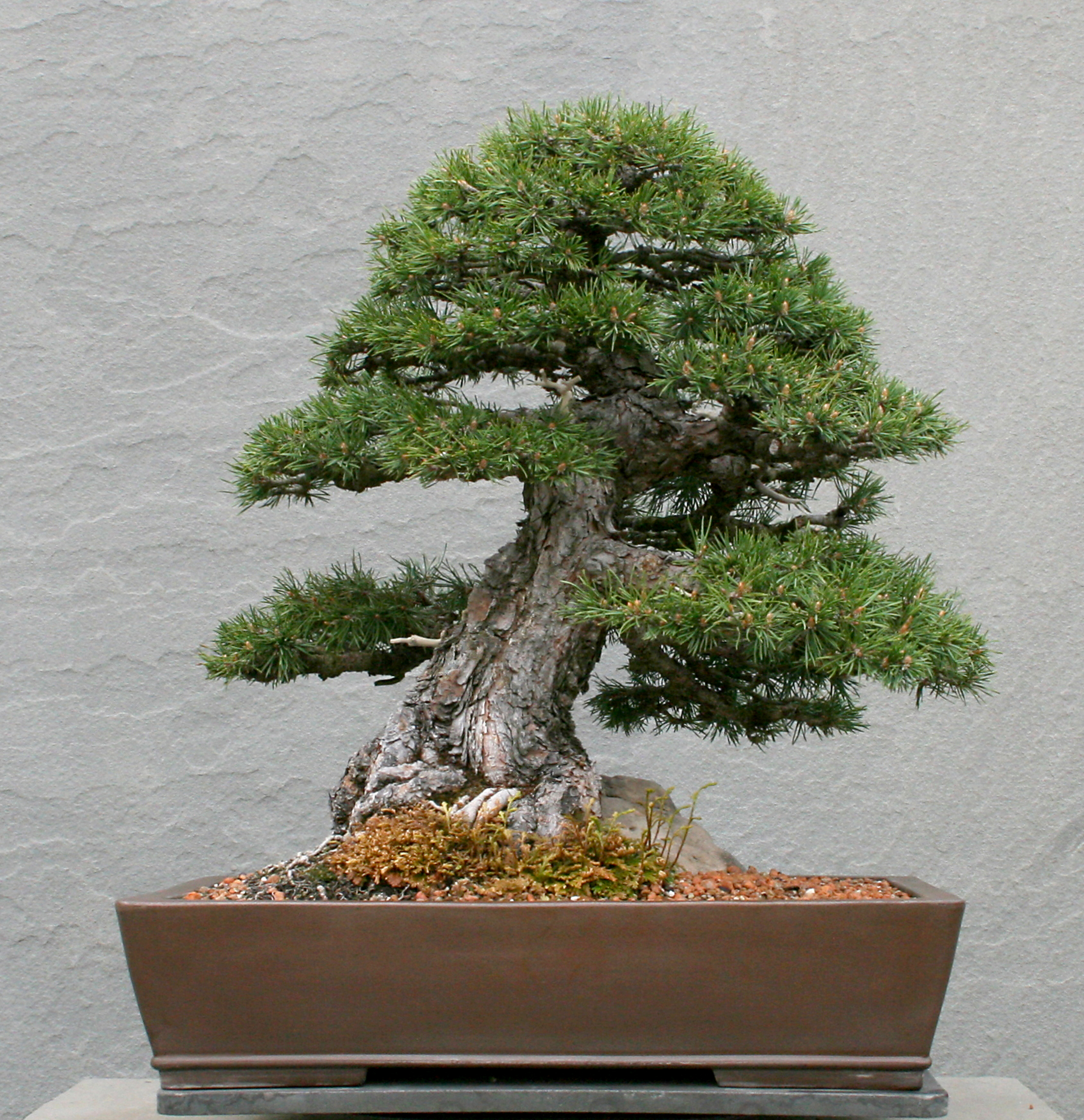
Scots Pine
Pinus sylvestris
In training since 1972
Gift of Roland Folse, 1990
Root-over-rock style.
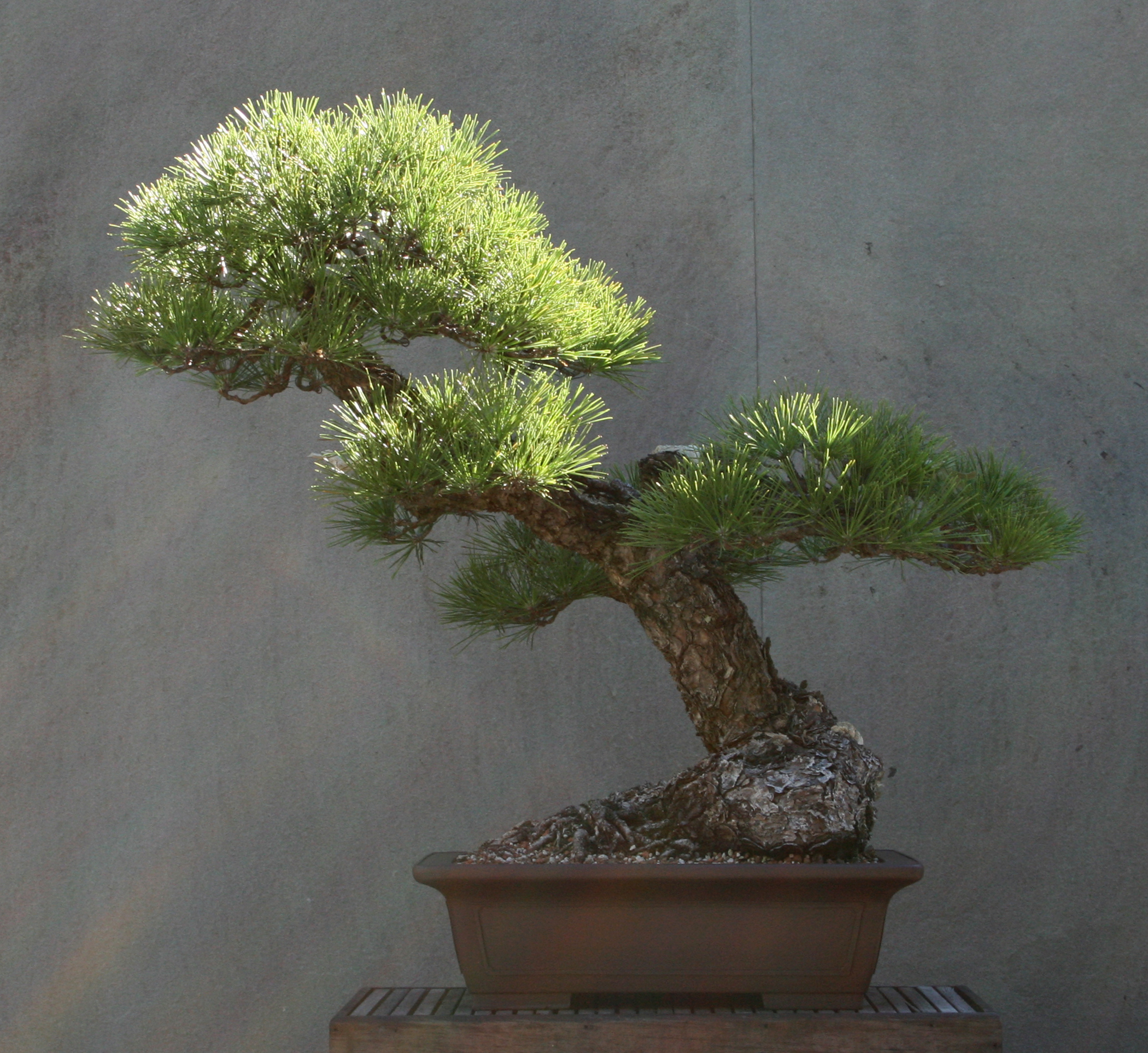
Japanese Black Pine
Pinus thunbergii
In training since 1970
Gift of Daniel Robinson, 1990
A very unusual bonsai! The trunk is an old ponderosa pine, but the grafted branches are Japanese black pine. Bonsai artists consider the 10-inch-long needles of the ponderosa to be out of scale for bonsai.
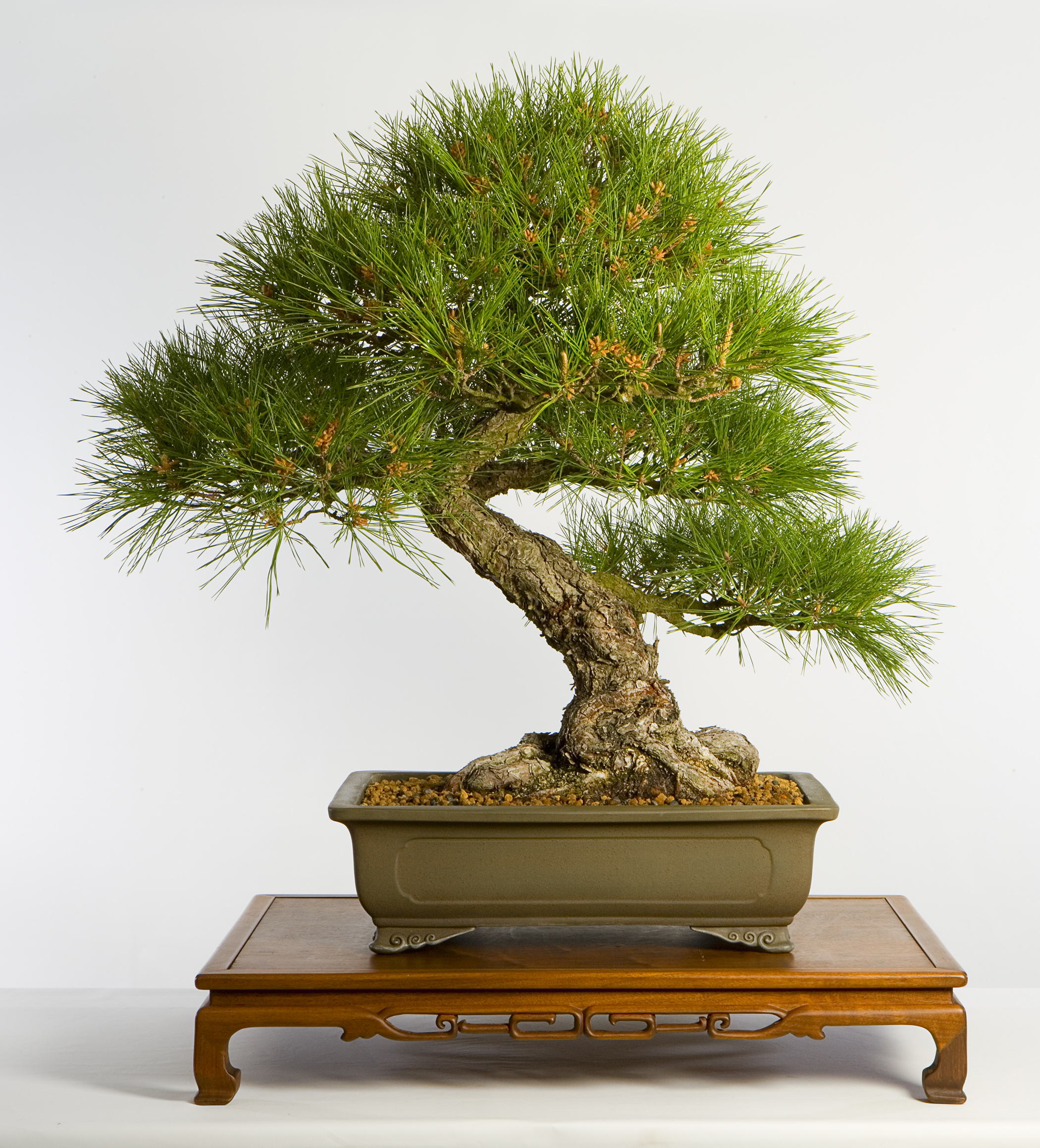
Japanese Black Pine
Pinus thunbergii
In training since 1950
Gift of Haruo Kaneshiro, 1990
Every summer pines grow new buds at the tips of their branches. In order to maintain a bonsai’s styling, the buds must be removed. Because the buds look like candles, this process is called “candling.”
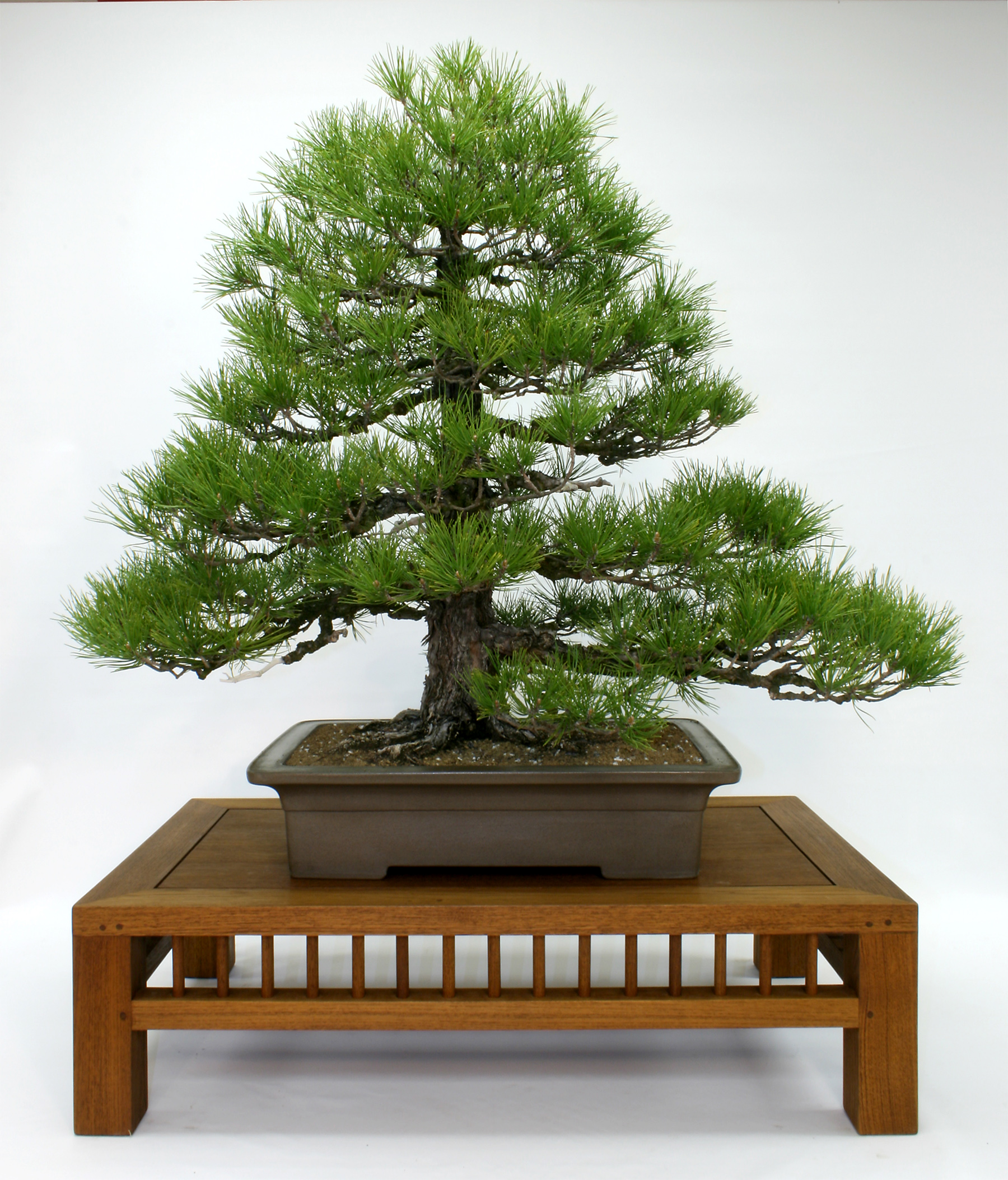
Japanese Black Pine
Pinus thunbergii
In training since 1955
Gift of George Yamaguchi, 1990
Most black pine bonsai are created from mature collected material. This bonsai is unusual because it has been in training since it sprouted from a seed.
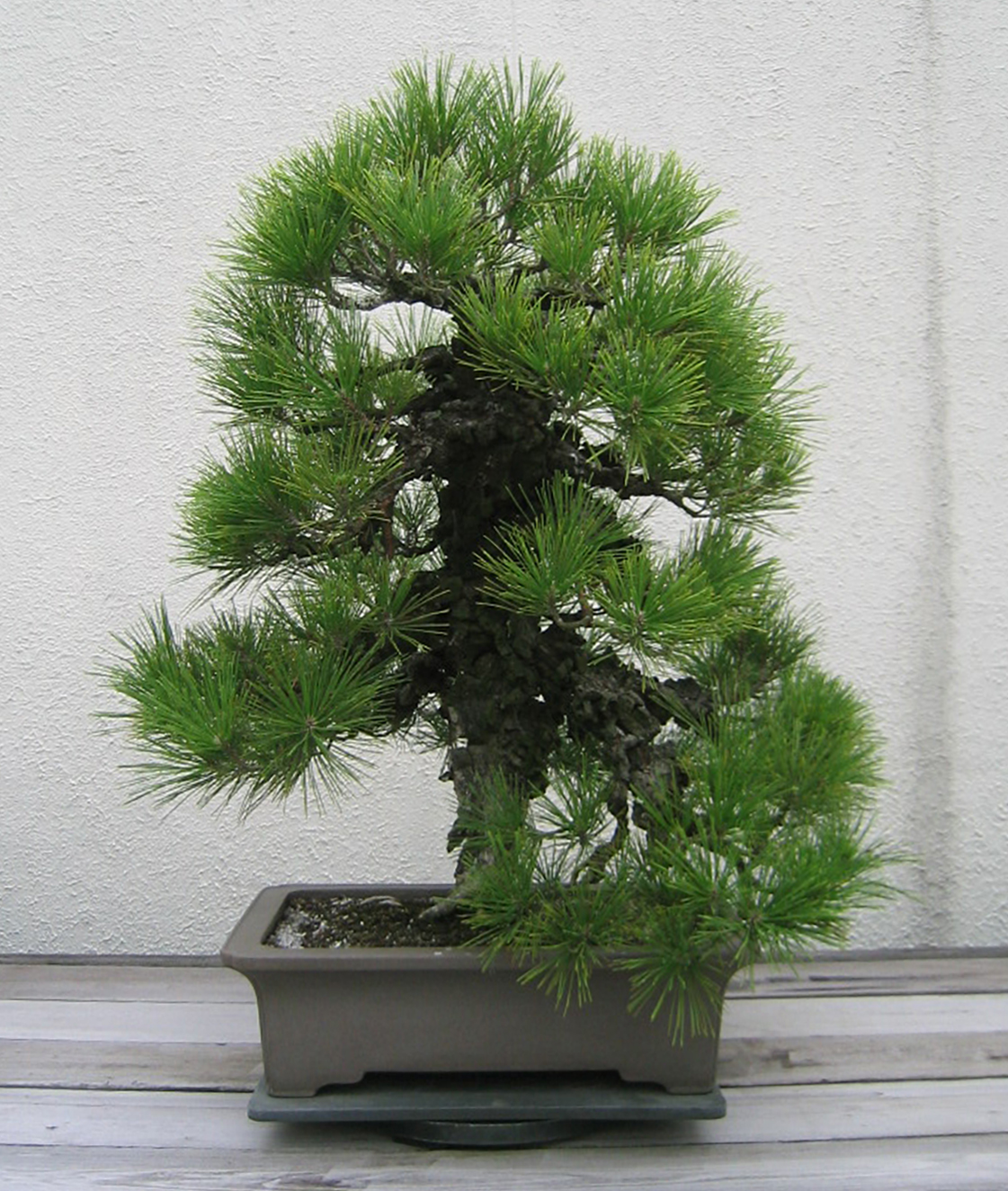
Cork-bark Japanese Black Pine
Pinus thunbergii Corticosa Group
In training since 1964
Gift of Muriel R. Leeds, 1986
Yuji Yoshimura created this bonsai by grafting cork-bark Japanese black pine to Japanese black pine roots.
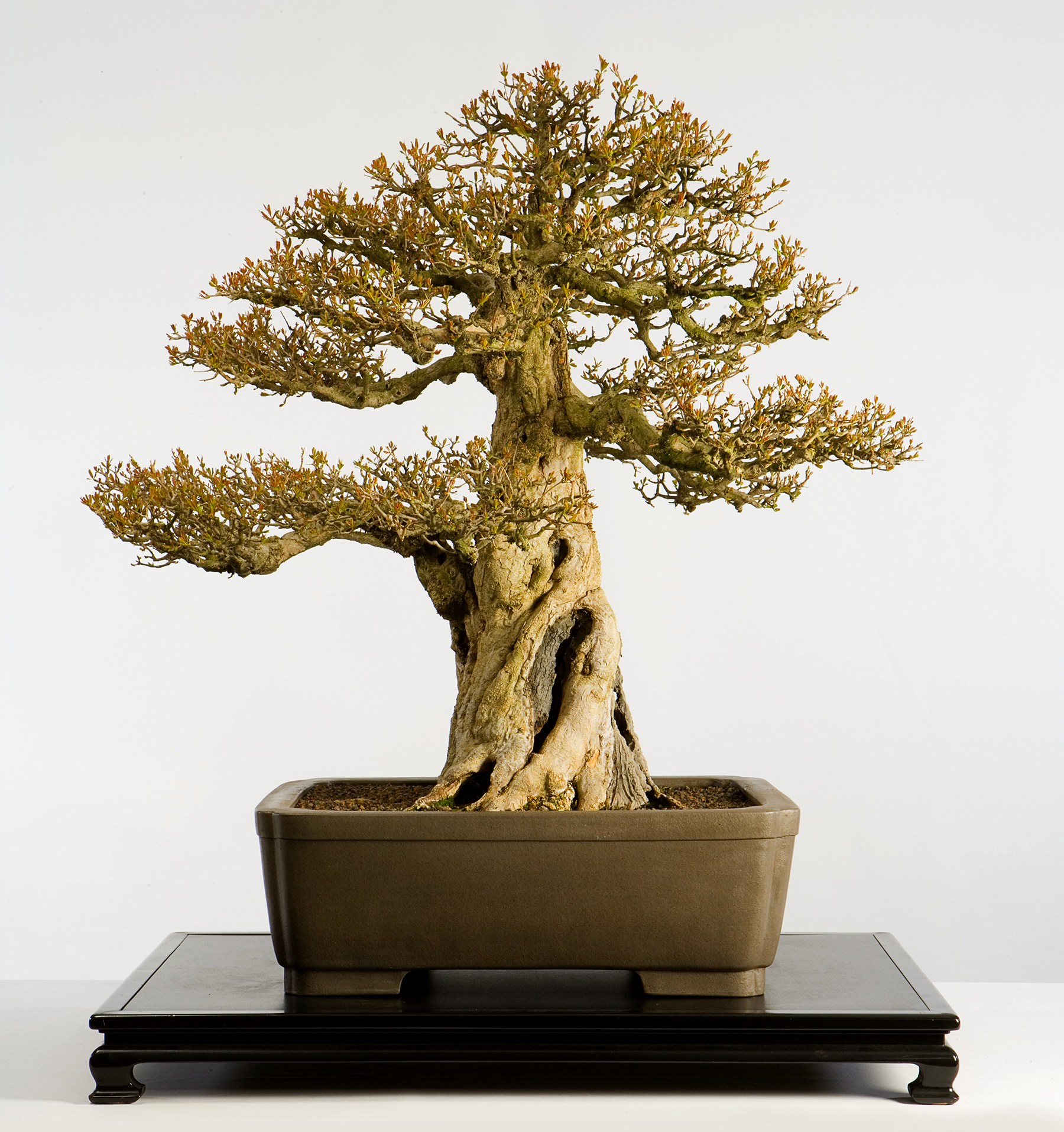
Pomegranate
Punica granatum
In training since 1963
Gift of Alice T. Naka, 1990
One of the goals of bonsai is to make a tree appear older and bigger than it actually is. By severely tapering the trunk, the artist is creating the illusion of a majestic old tree.
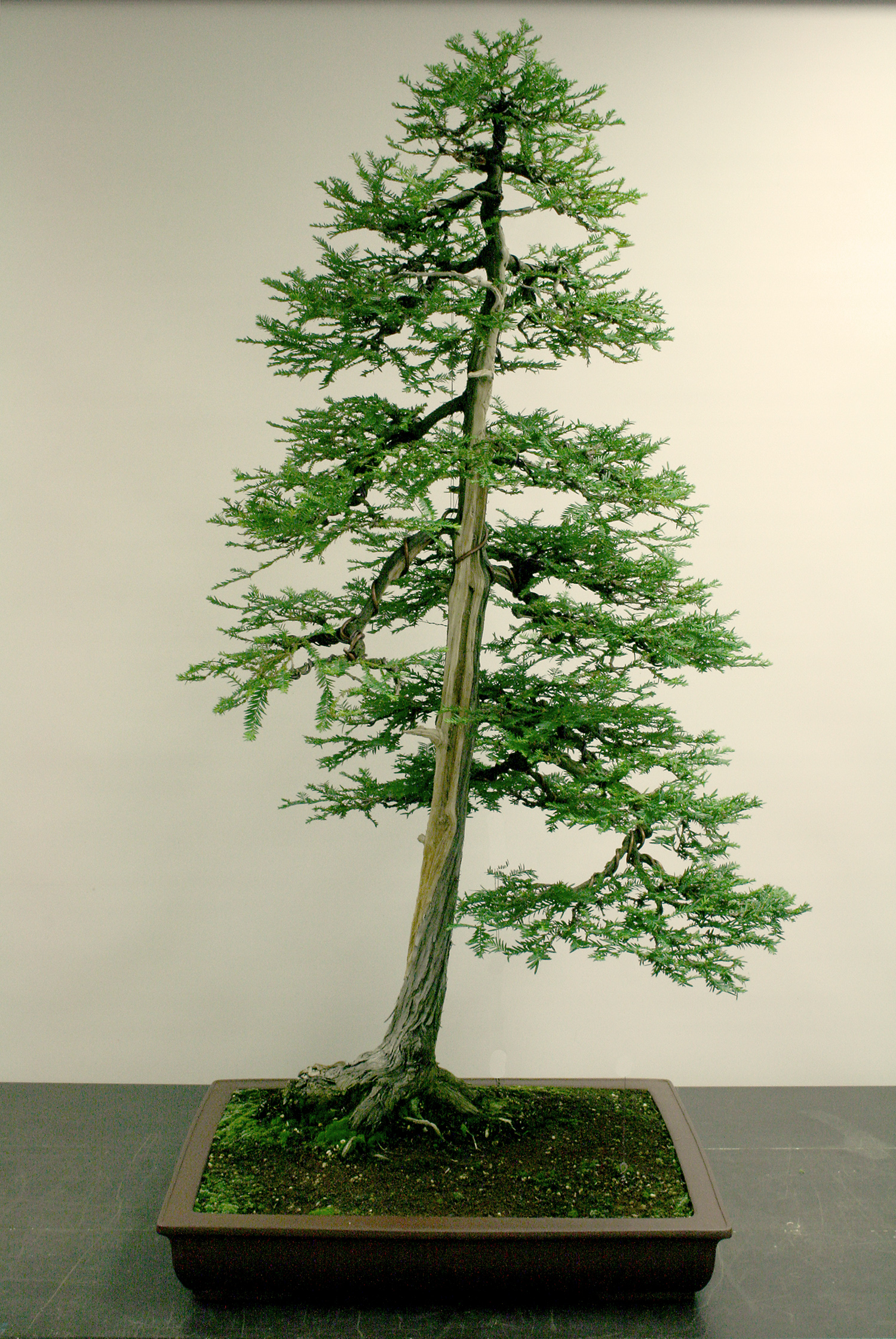
Coastal Redwood
Sequoia sempervirens
In training since 1954
Gift of June M. Chambers, 1990
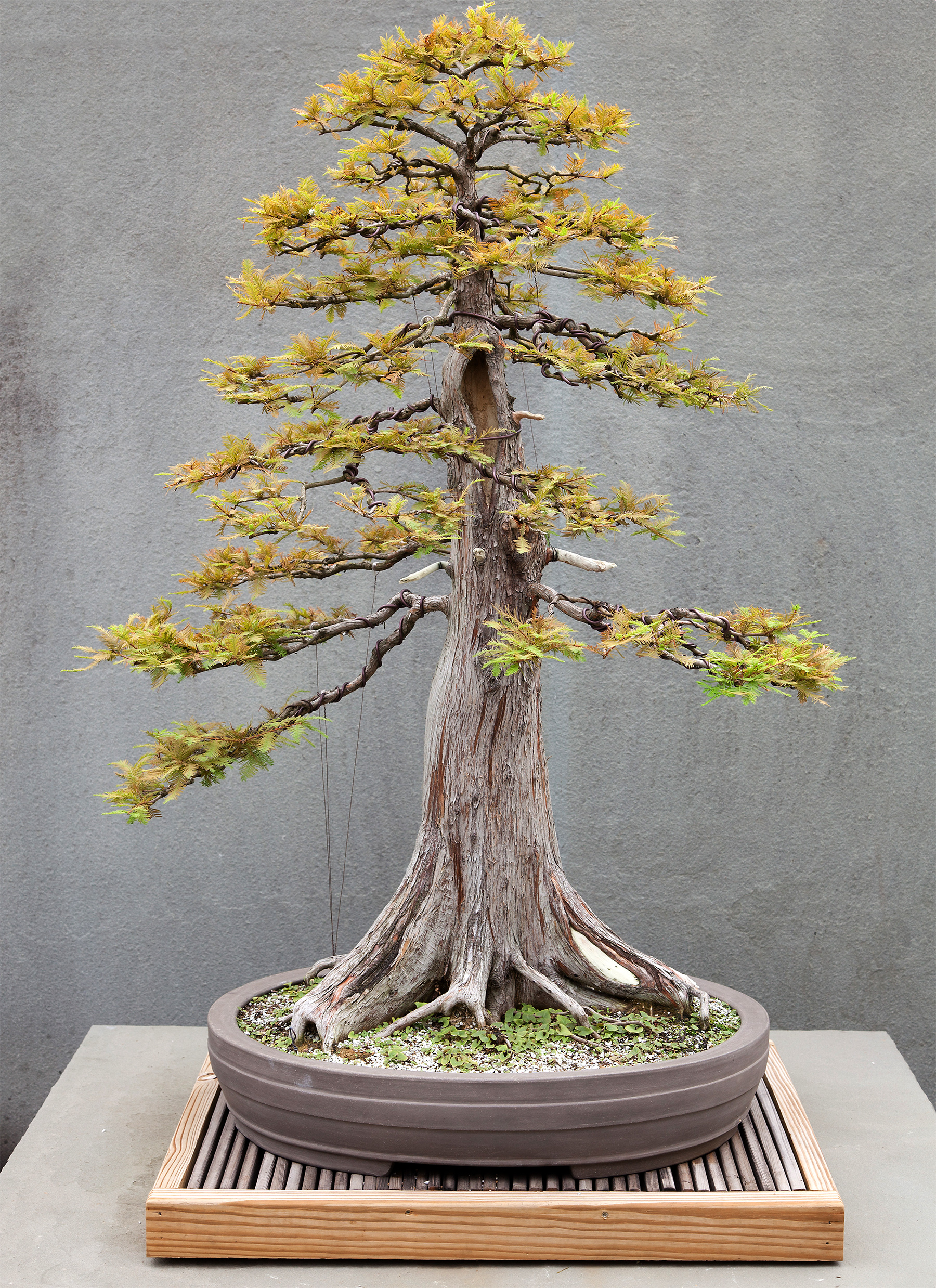
Bald-cypress
Taxodium distichum var. distichum
In training since 1987
Gift of Guy Guidry, 1990
Before it became a bonsai this tree was 25 feet tall. The trunk of a mature tree provides the wide flare at the base of the tree so desirable in bonsai.
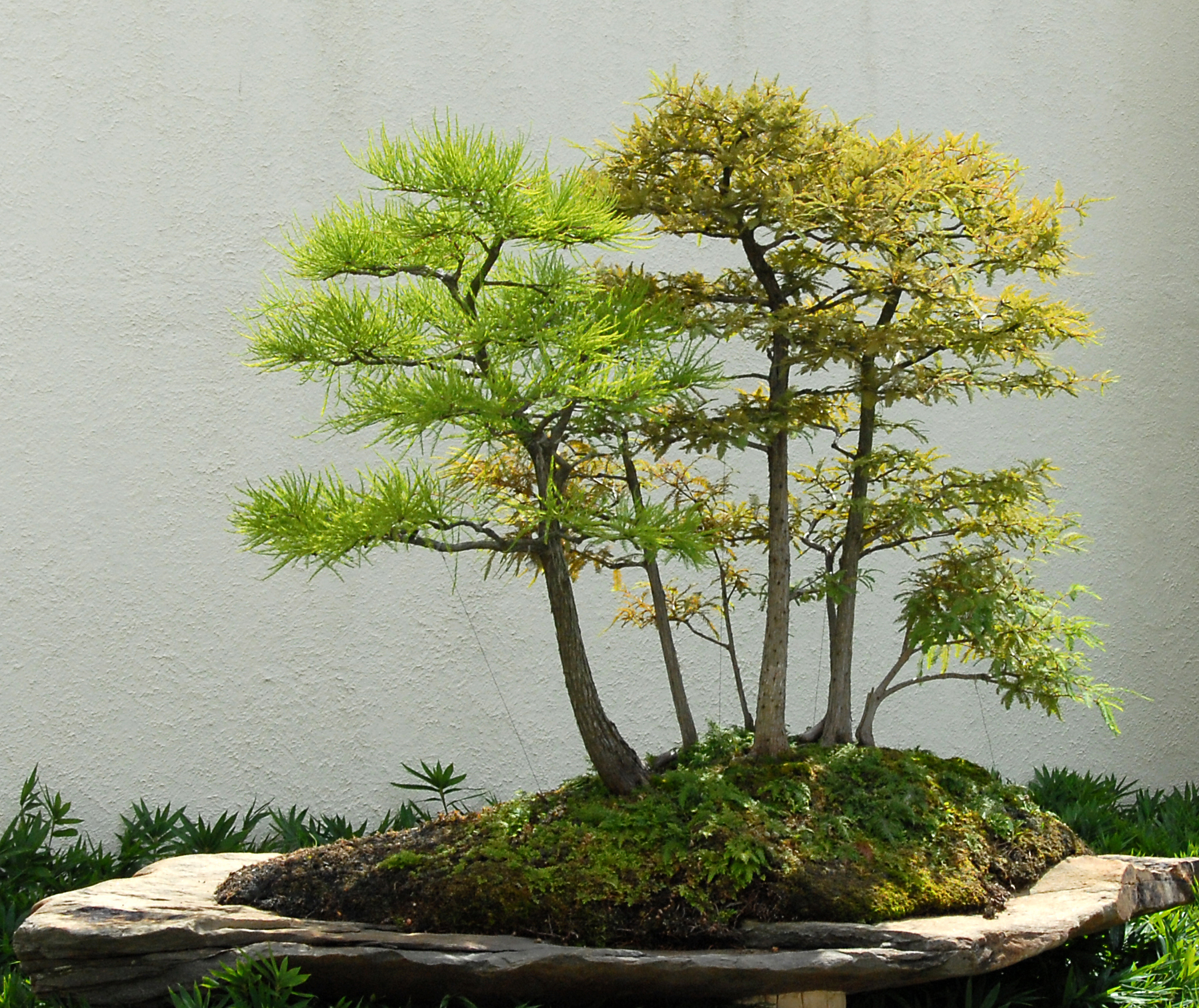
Bald-cypress and Pond-cypress
Taxodium distichum var. distichum and Taxodium distichum var. imbricarium
In training since 1988
Gift of Jim Fritchey & Dick Wild, 1990
The creators of this forest style bonsai used two different types of cypress collected in southwest Florida, planting them atop a 2000-pound natural rock slab.
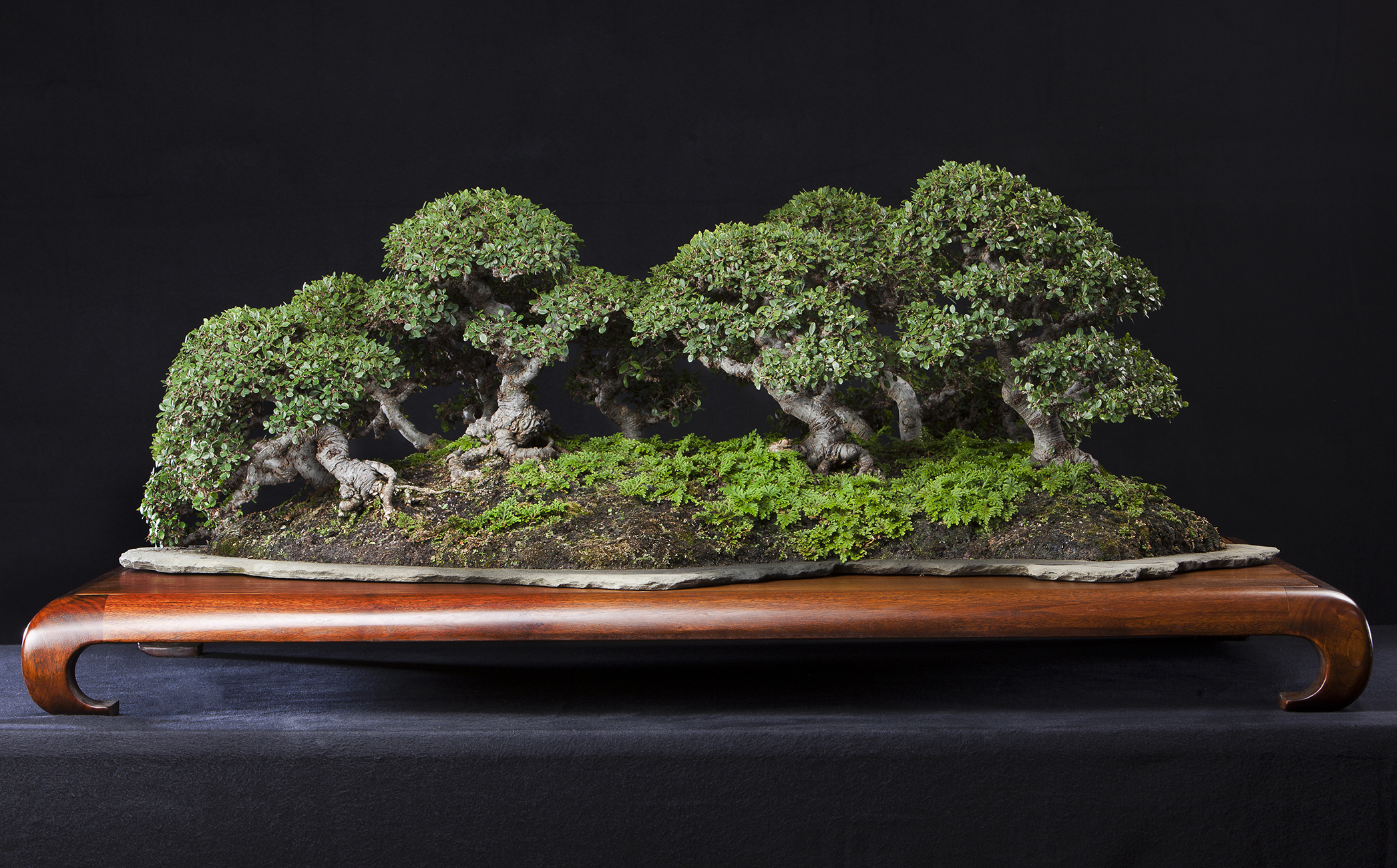
Catlin Elm
Ulmus parvifolia 'Catlin'
In training since 1988
Gift of Susanne Barrymore, 1990
This forest planting was created from cuttings of a mutant contorted Chinese elm developed as a cultivar specifically for use in bonsai.

Chinese Elm
Ulmus parvifolia
In training since 1970
Gift of Marybel Balendonck, 1990
Do you "feel" the wind blowing through this forest? The artist has arranged and styled the trees so they slant to the left, as if in the presence of a steady breeze.
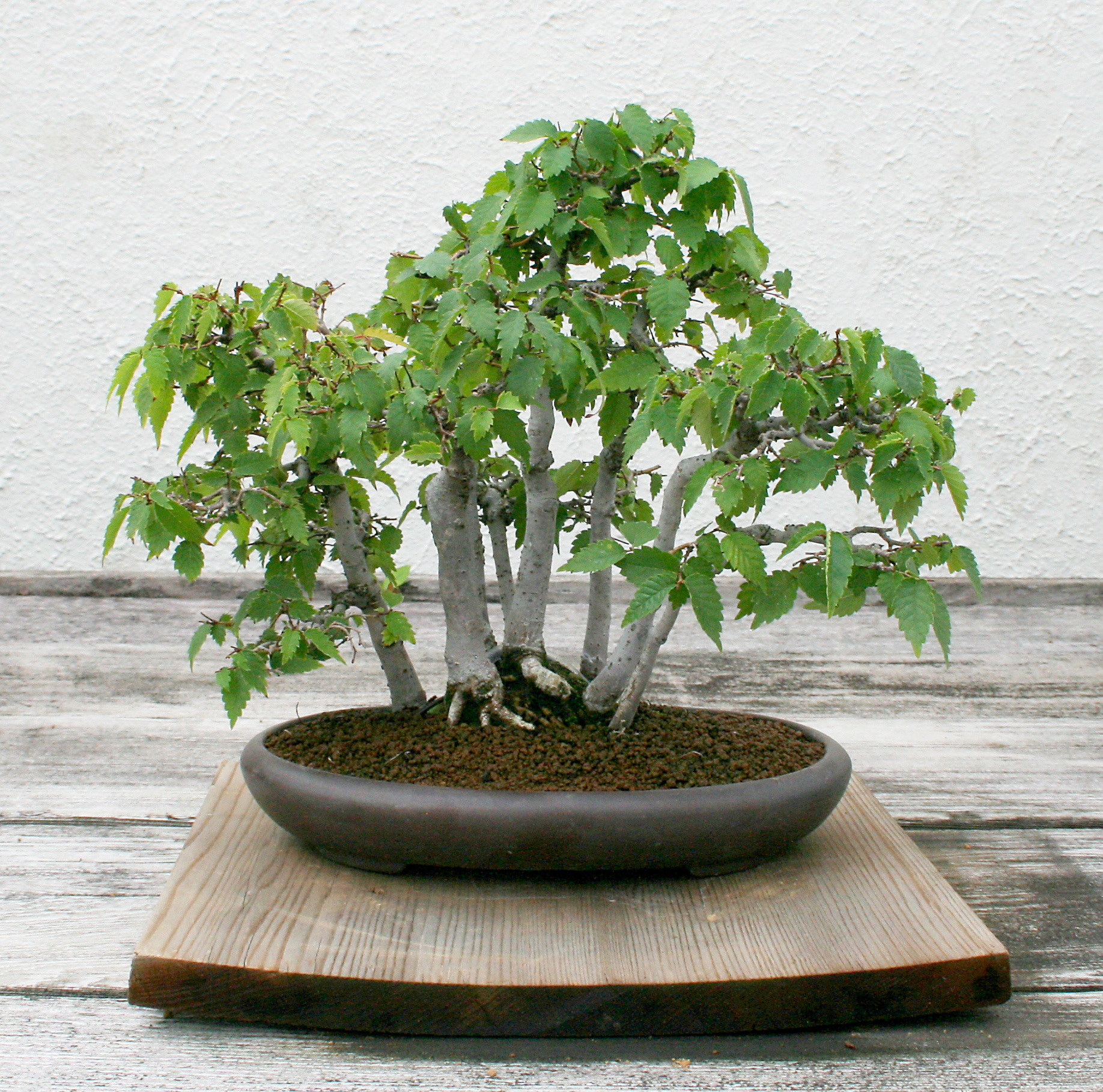
Japanese Zelkova
Zelkova serrata
In training since 1972
Gift of Doris W. Froning, 1990

Ficus microcarpa 'Kaneshiro'
In training since 1975
Gift of Haruo Kaneshiro, 1990
This ficus was hybridized by Hawaii's foremost bonsai master, Haruo Kaneshiro. The styling imitates the natural look of old banyan trees in the tropics, with their aerial roots reaching down to add multiple “trunks.”
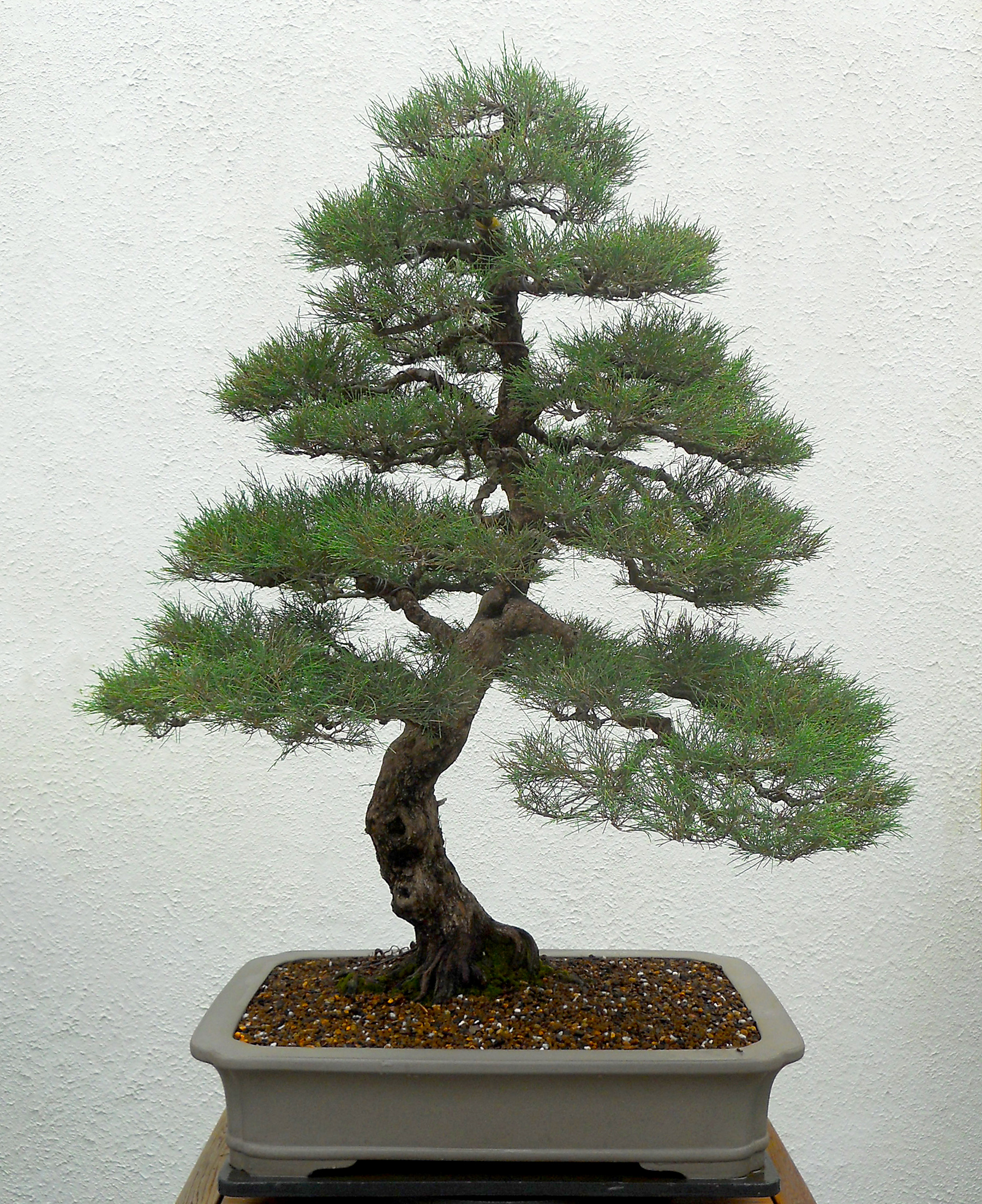
Ironwood
Casuarina equistifolia
In training since 1978
Gift of Edwin S. Nishida, 1990
This tropical tree native to Australia looks like a pine, but unlike pine, its foliage grows continuously and needs to be plucked back to give it a tidy look for a bonsai.
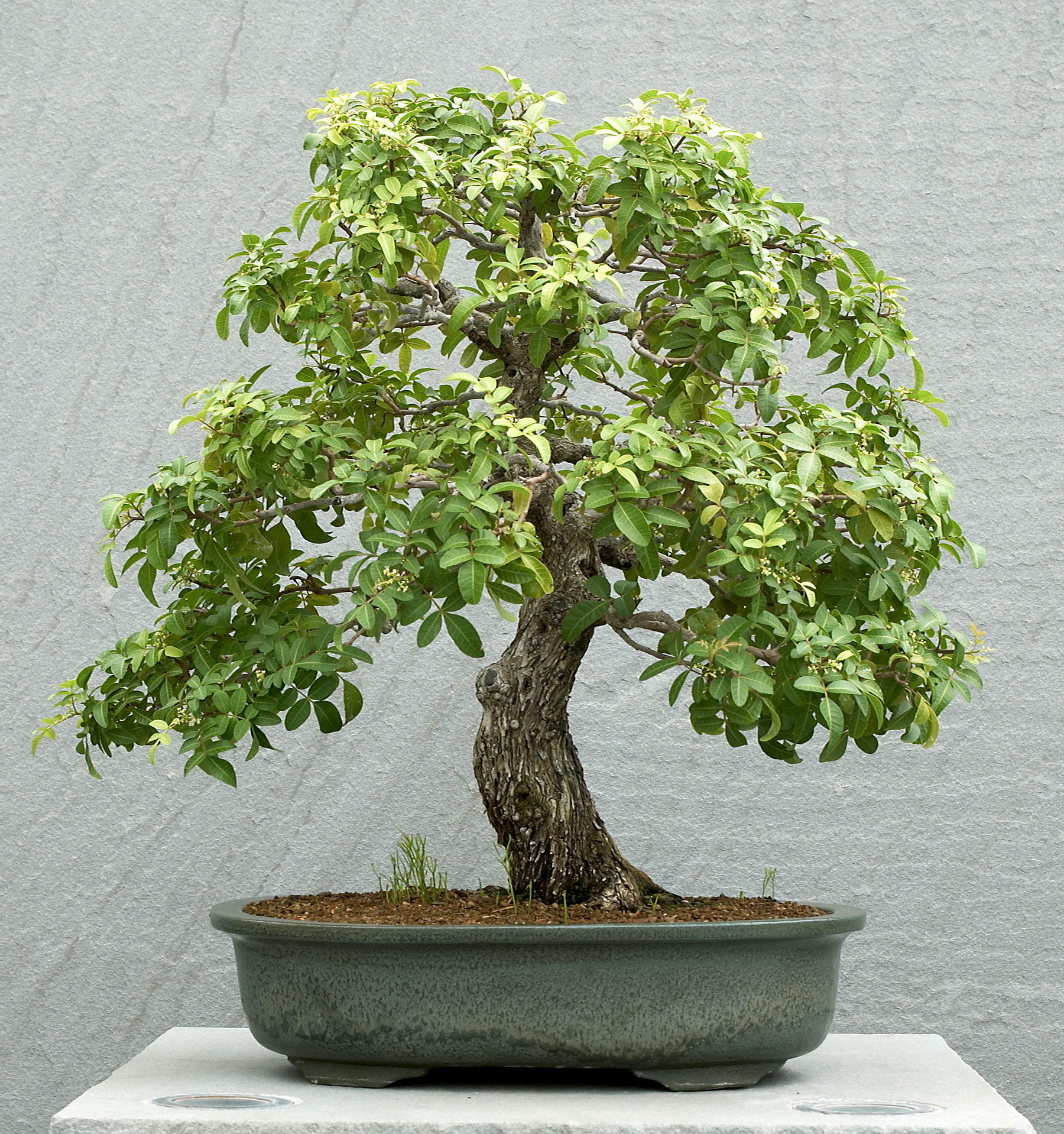
Brazilian Peppertree
Schinus terebinthifolia
In training since 1973
Gift of Edward Nakanishi, 1990
This tropical tree native to South America flowers in the early winter.
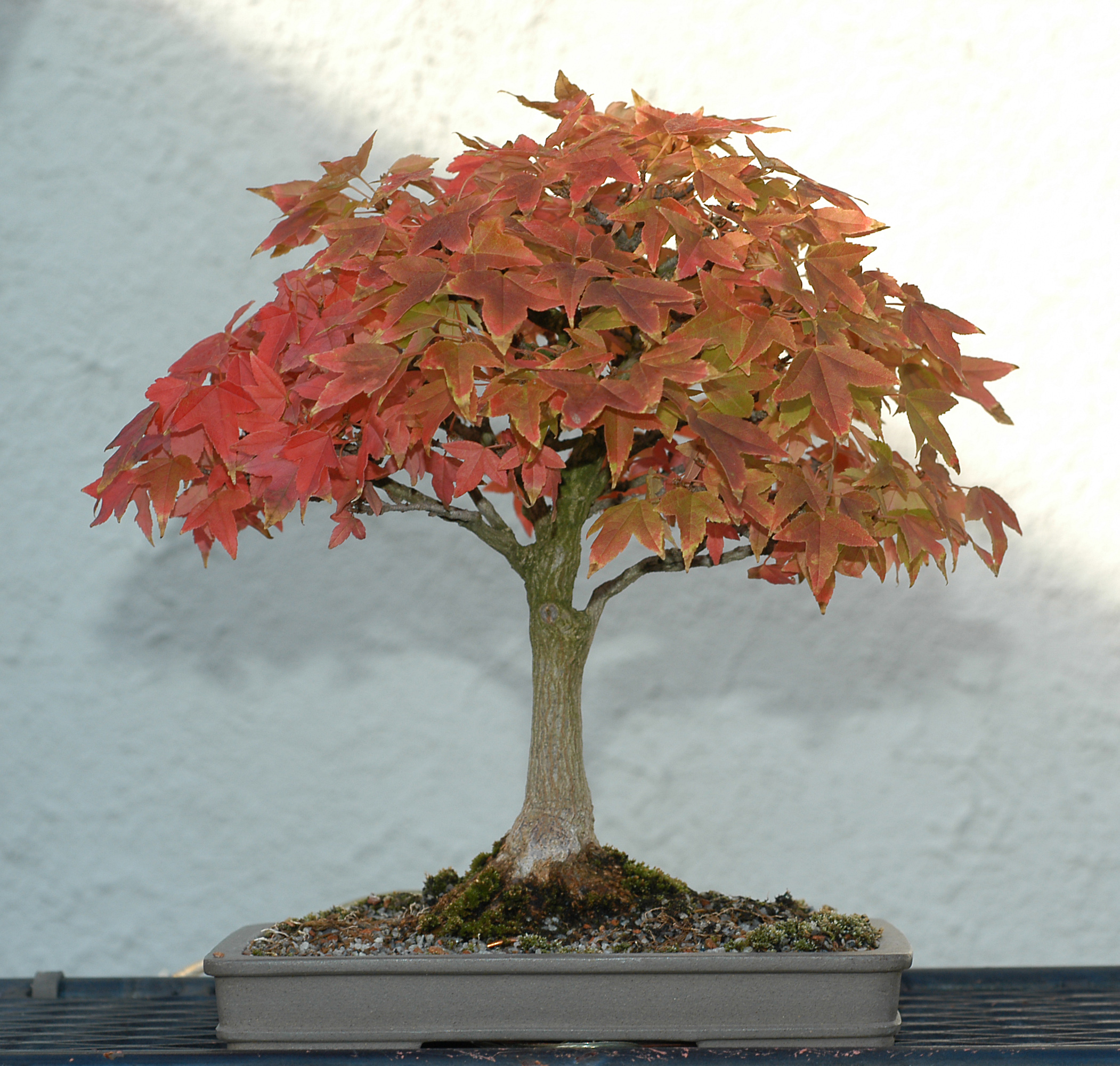
Trident Maple
Acer buergerianum
In training since 1976
Gift of Doris W. Froning, 1994
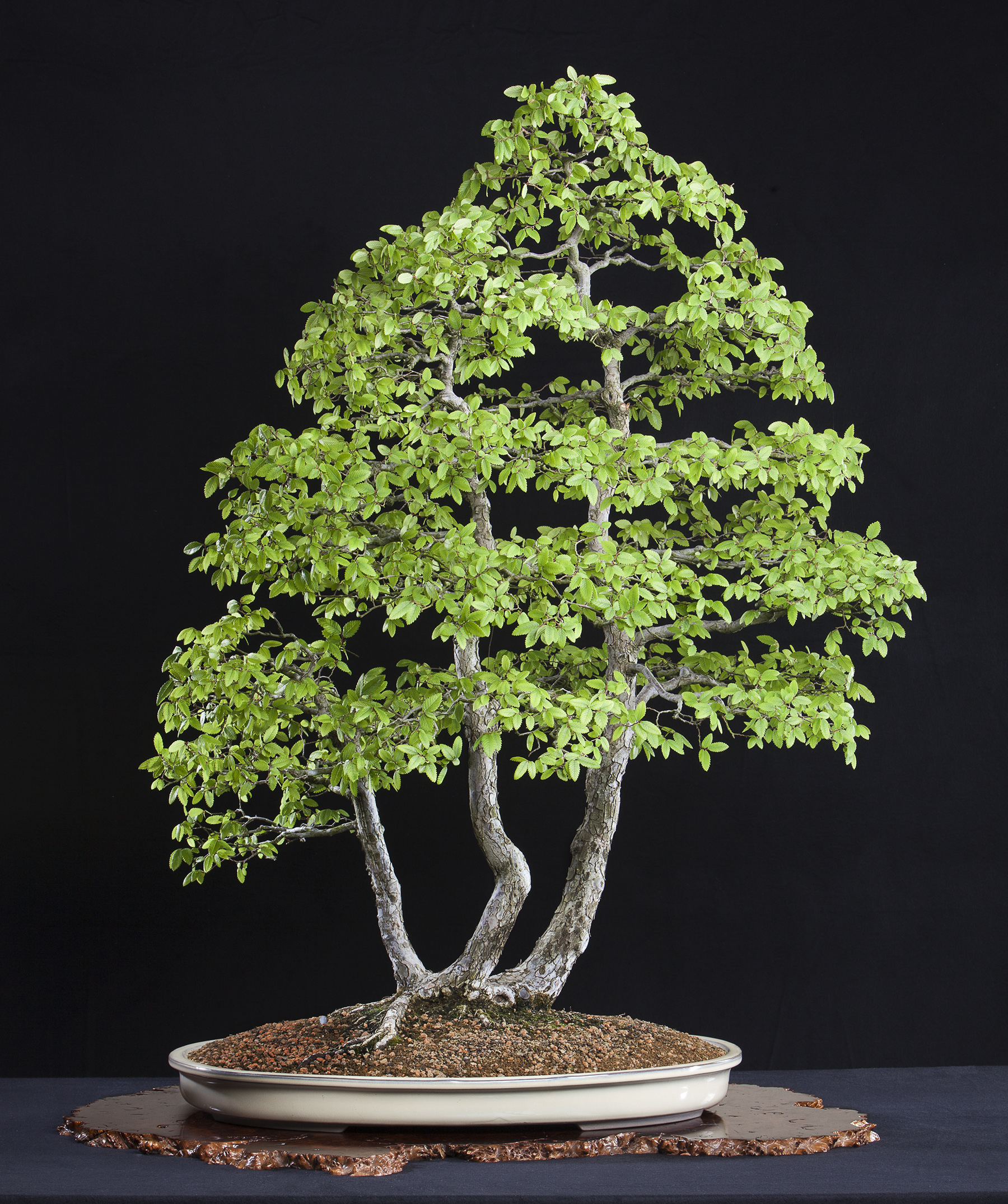
Cedar Elm
Ulmus crassifolia
In training since 1981
Gift of Arch R. Hawkins, 1996
This North American native was collected in a field in central Texas. The fine twigging and rough silvery bark are most appreciated in winter after the leaves have fallen.
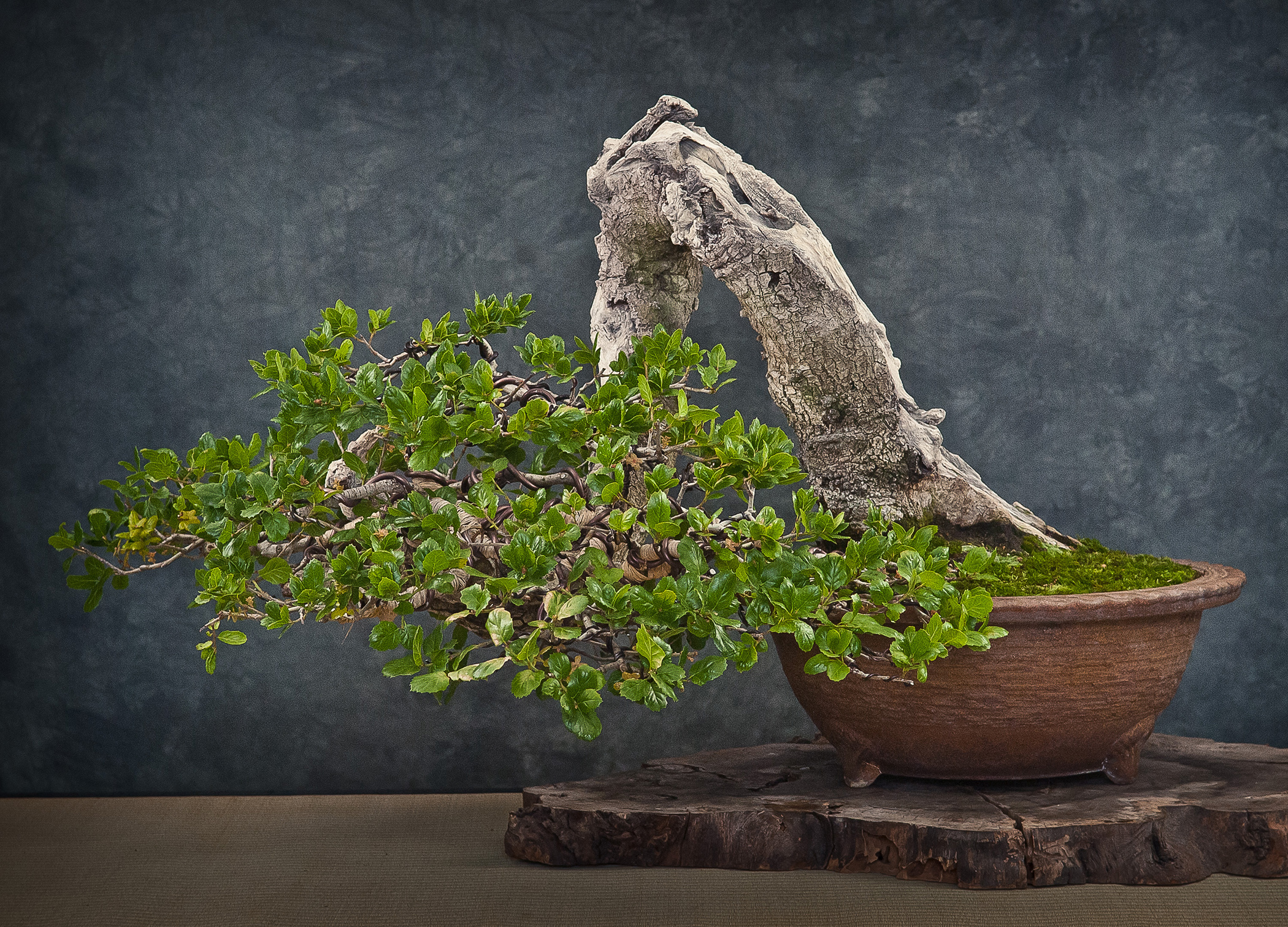
Coast Live Oak
Quercus agrifolia
In training since 1986
Gift of John Y. Naka, 1997
Interesting trunks like this one are usually found in the wild. John found this coast live oak in 1986 on a cattle ranch about 55 miles northwest of Santa Barbara, CA.
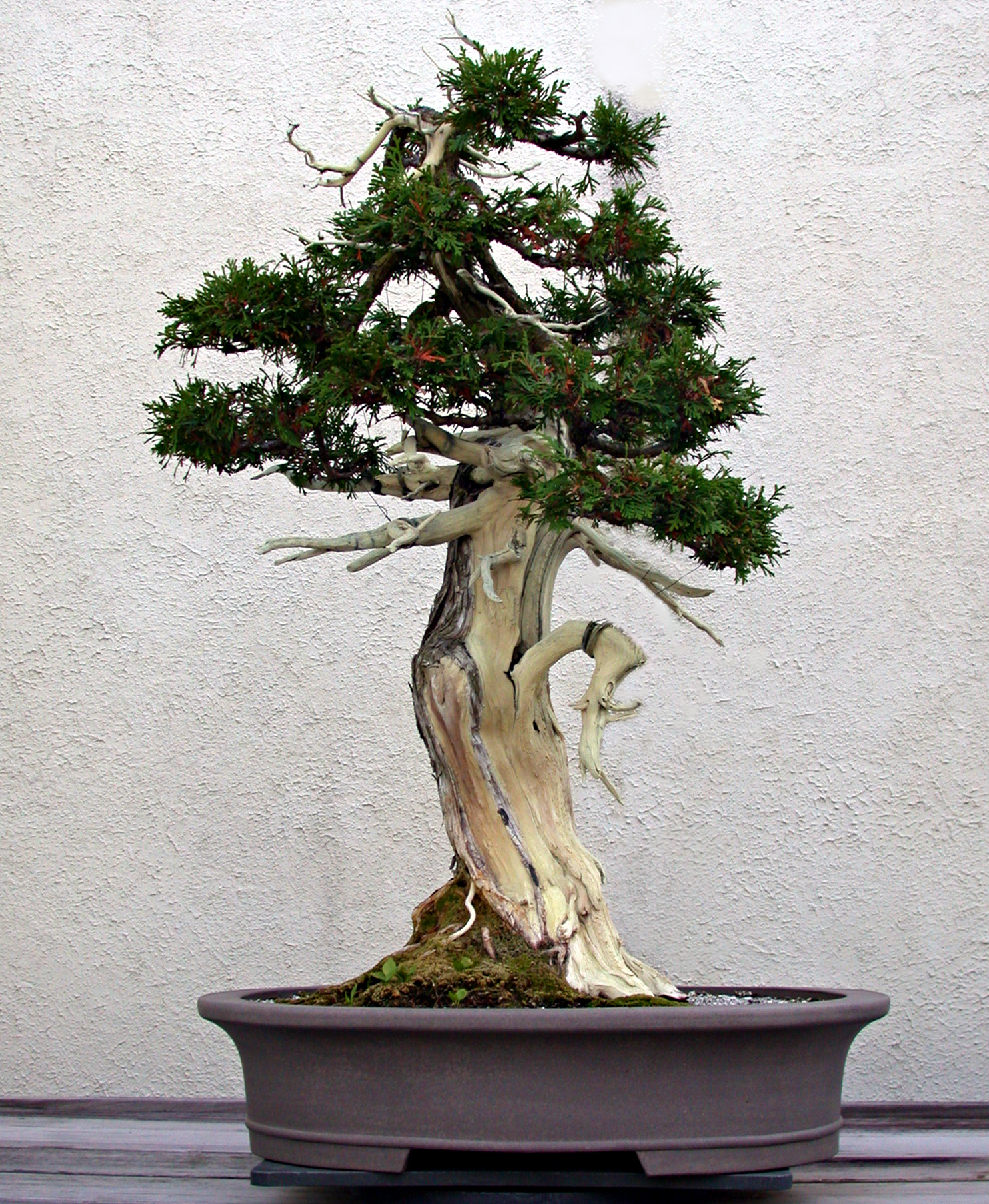
Northern White-cedar
Thuja occidentalis
In training since 1989
Gift of Toronto Bonsai Society, 1996
Northern white-cedars are the oldest trees in Eastern North America. This tree was collected in Canada and styled to reflect its northern origins where heavy snows leave old trees with multiple broken, dead branches.
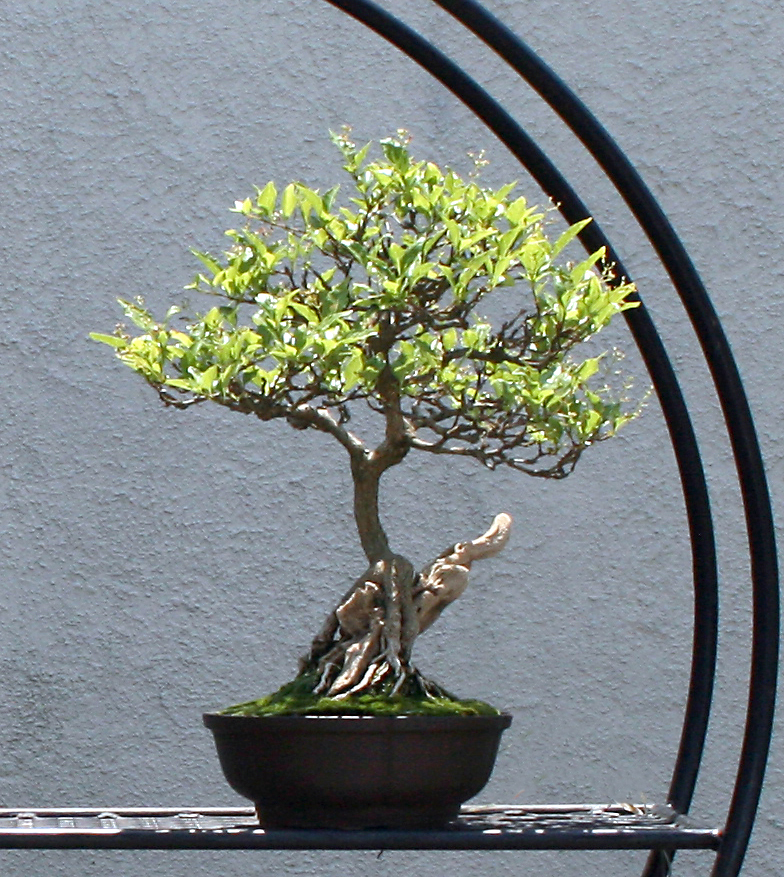
Musk-maple
Premna microphylla
In training since 1988
Gift of William & Joan Clark, 1999
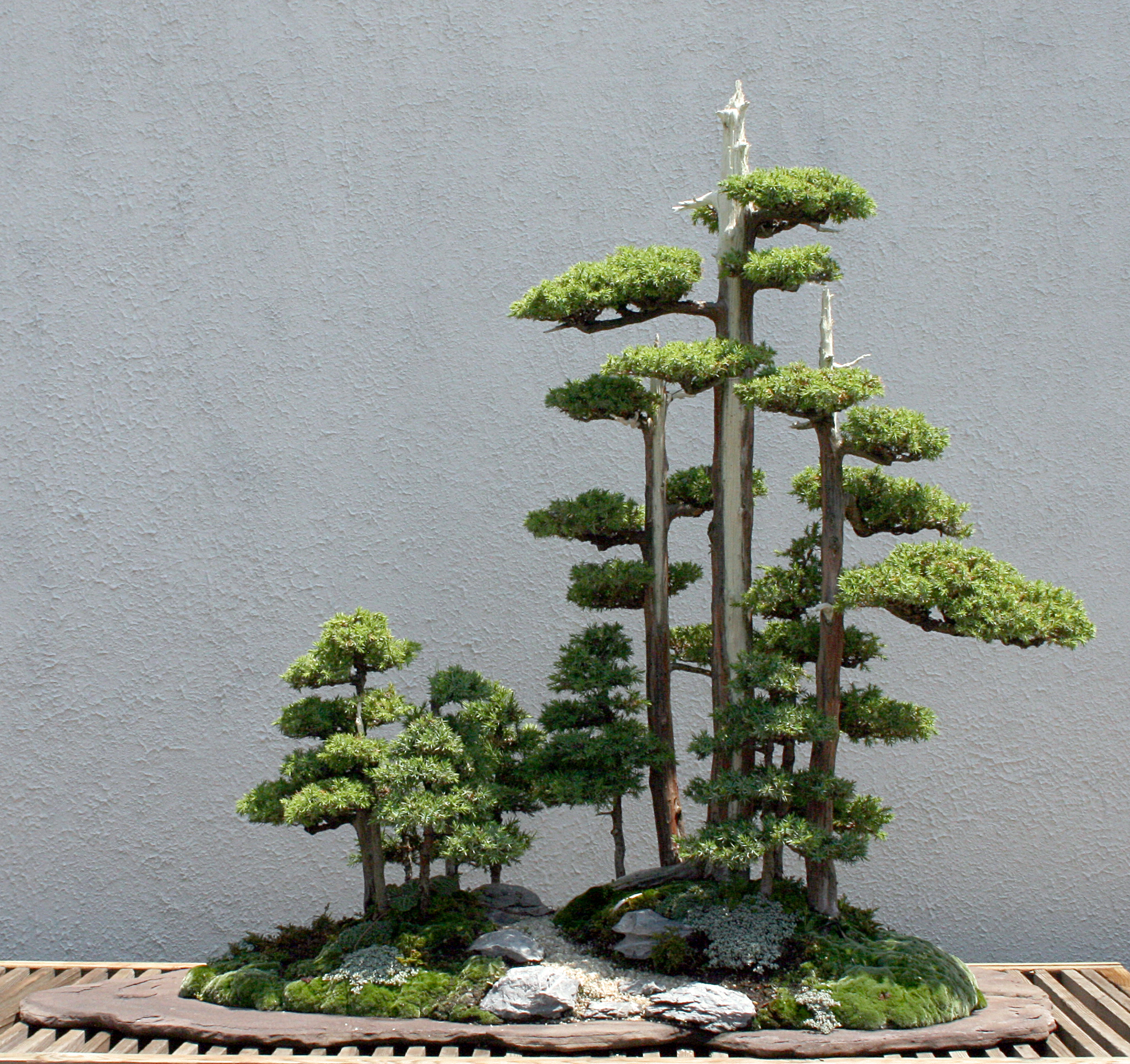
Chinese Juniper
Juniperus chinensis 'Femina'
In training since 1970
Gift of Mas Moriguchi, 1999
Can you imagine walking down the path in this miniature landscape? The artist styled this scene after a redwood forest. By including short trees and little plants he made the tall trees appear to be giants.
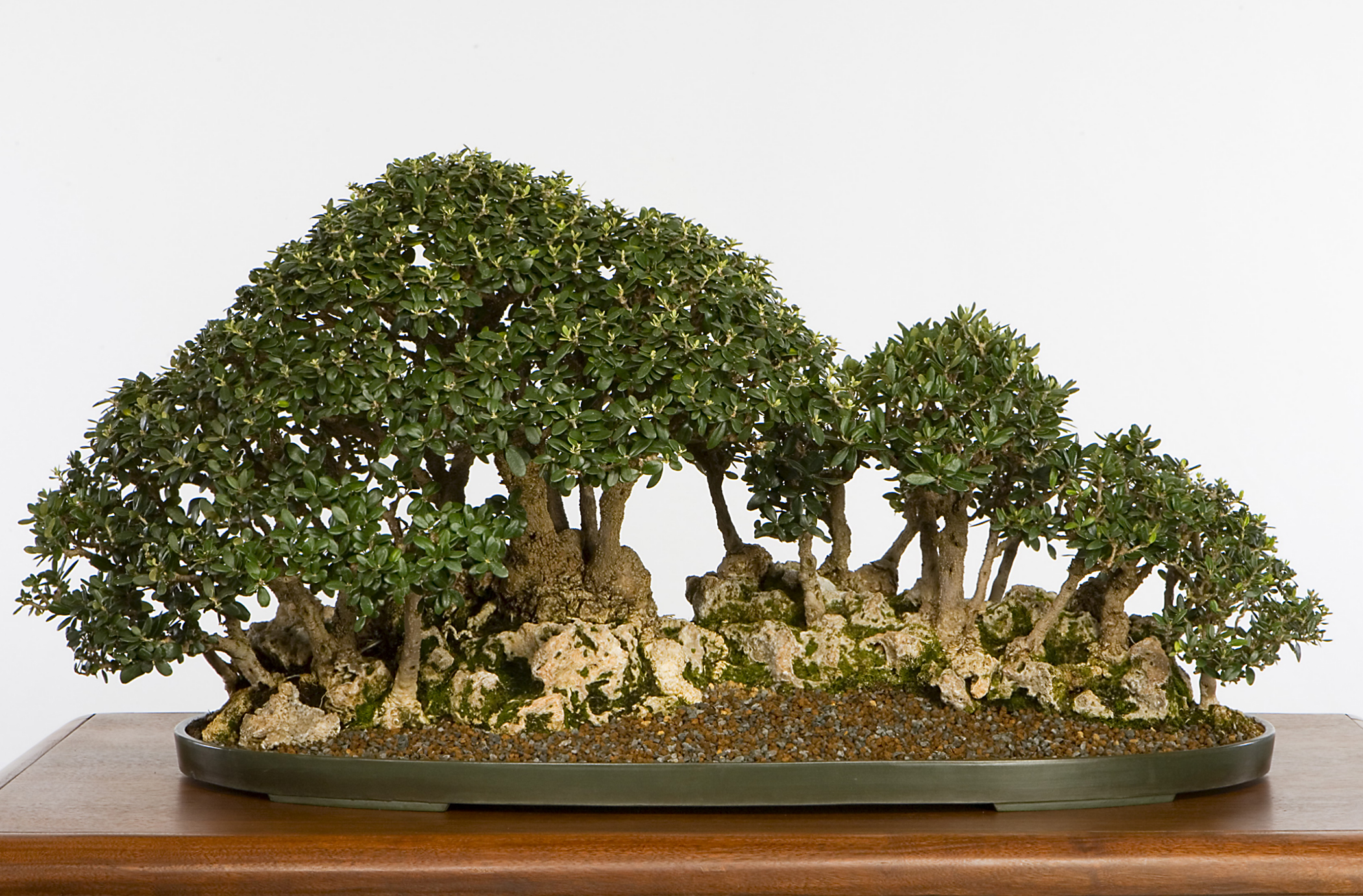
Olive
Olea europaea
In training since 1972
Gift of Melba Tucker, 2000
Do you see an old olive grove on a rugged coast in the Mediterranean? Like a living postcard, these tray landscapes can conjure up distant places.
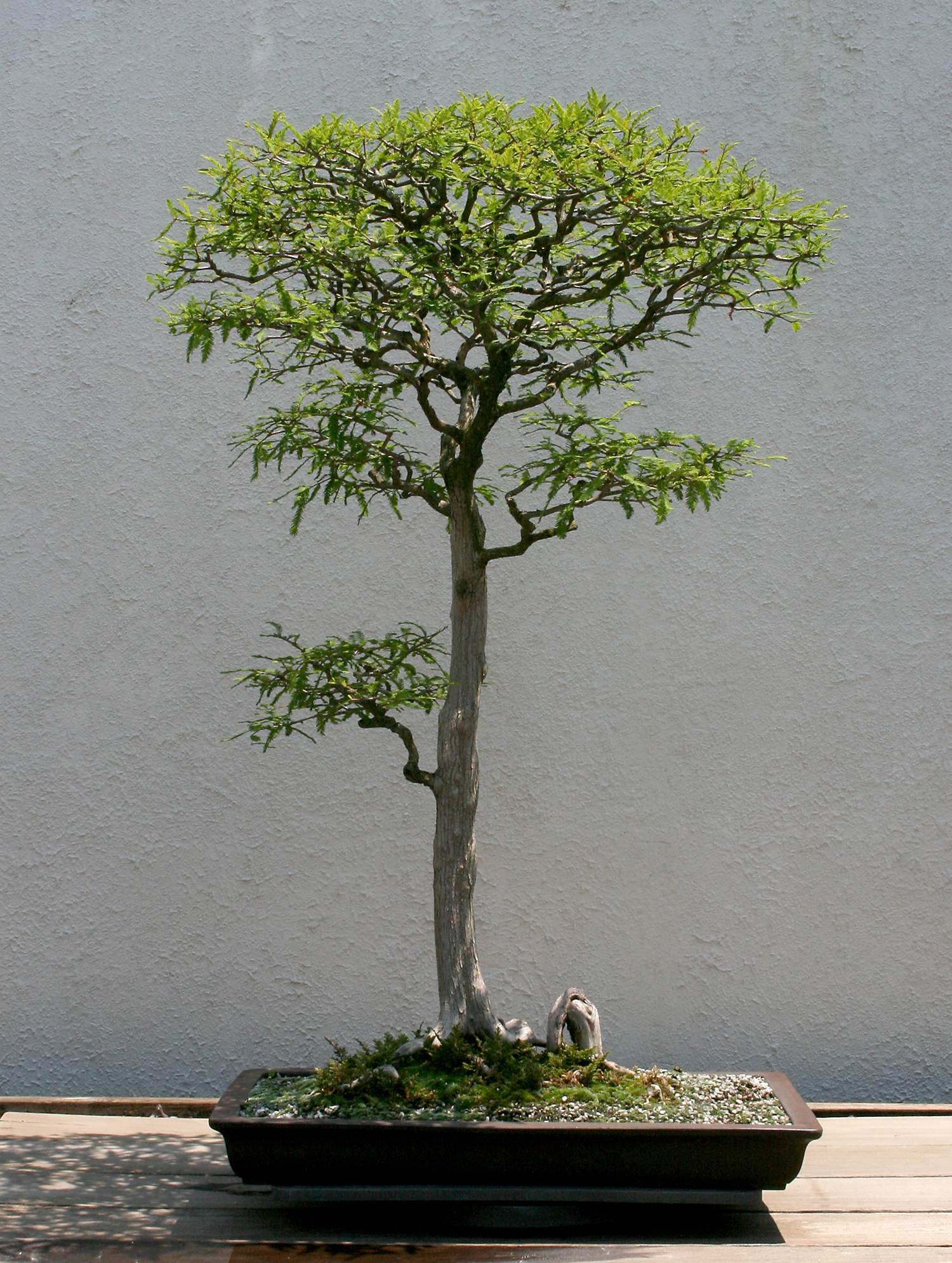
Bald-cypress
Taxodium distichum var. distichum
In training since 1972
Gift of Vaughn L. Banting, 2000
You won't find this tree shape in Asian bonsai. The flat-top form is unique to the old bald cypress trees that grow in the southeast wetlands of the United States.
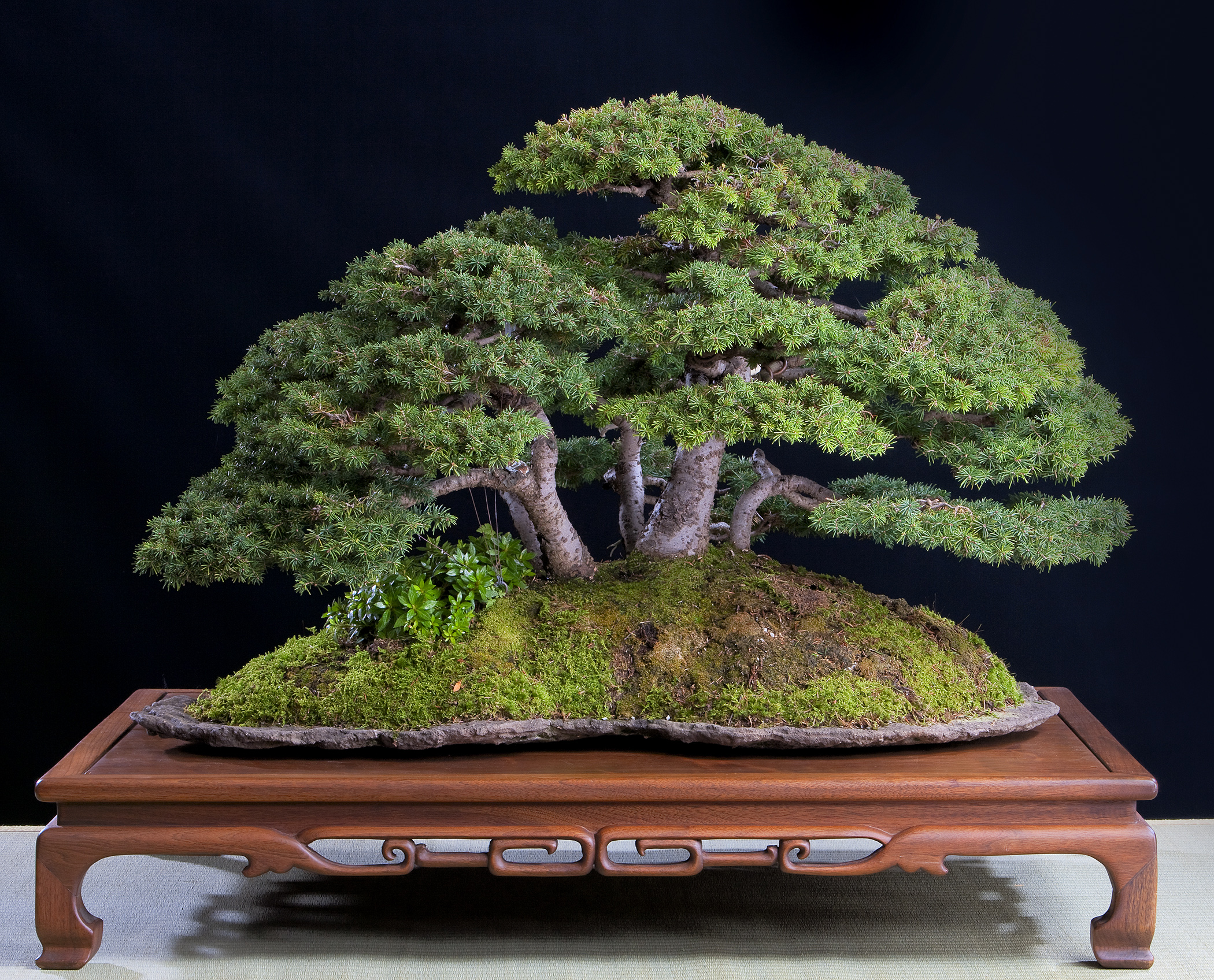
Bird's Nest Norway Spruce
Picea abies 'Nidiformis'
In training since 1956
Gift of Philip Tacktill, 2001
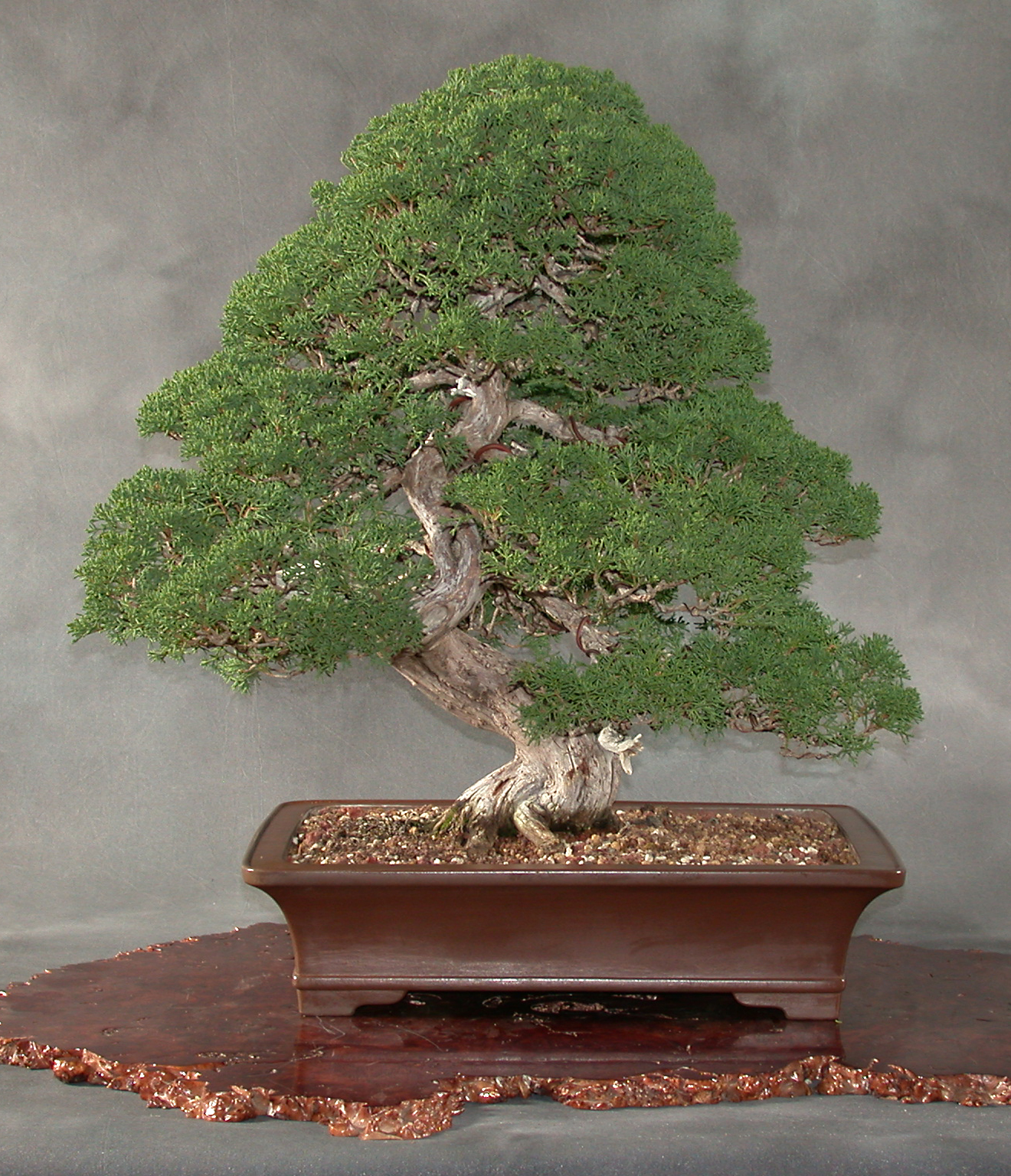
Sargent Juniper
Juniperus chinensis var. sargentii
Training age unknown
Gift of Sherwin Mitchell, 2002
Even though the trunk has a lot of twists and turns, the top of the tree is aligned over the base in a good example of the informal upright bonsai style.
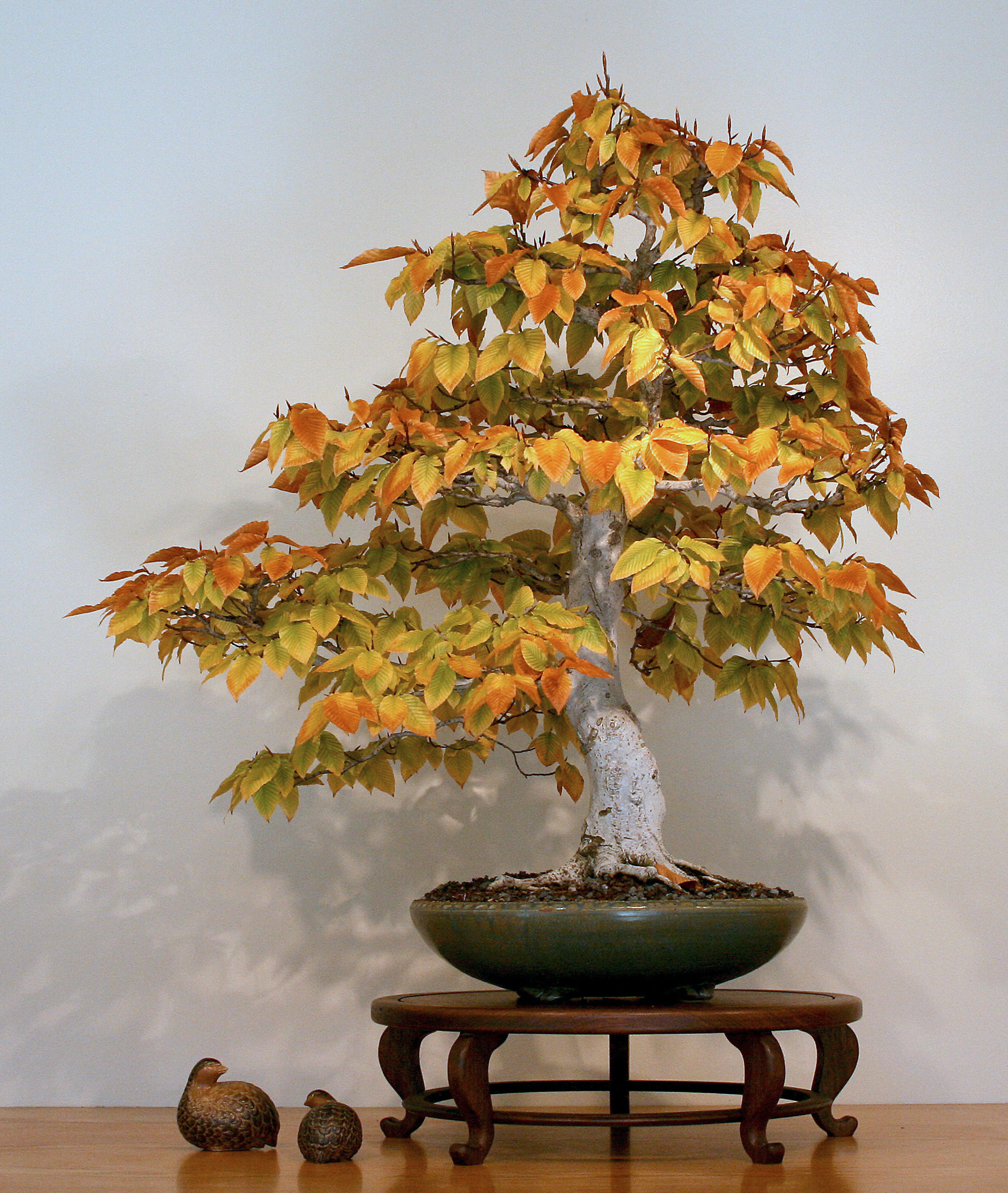
American Beech
Fagus grandifolia
In training since 1979
Gift of Fred H. Mies, 2003
This species is native to eastern North America. Its smooth, silver-gray bark is a nice contrast to the foliage.
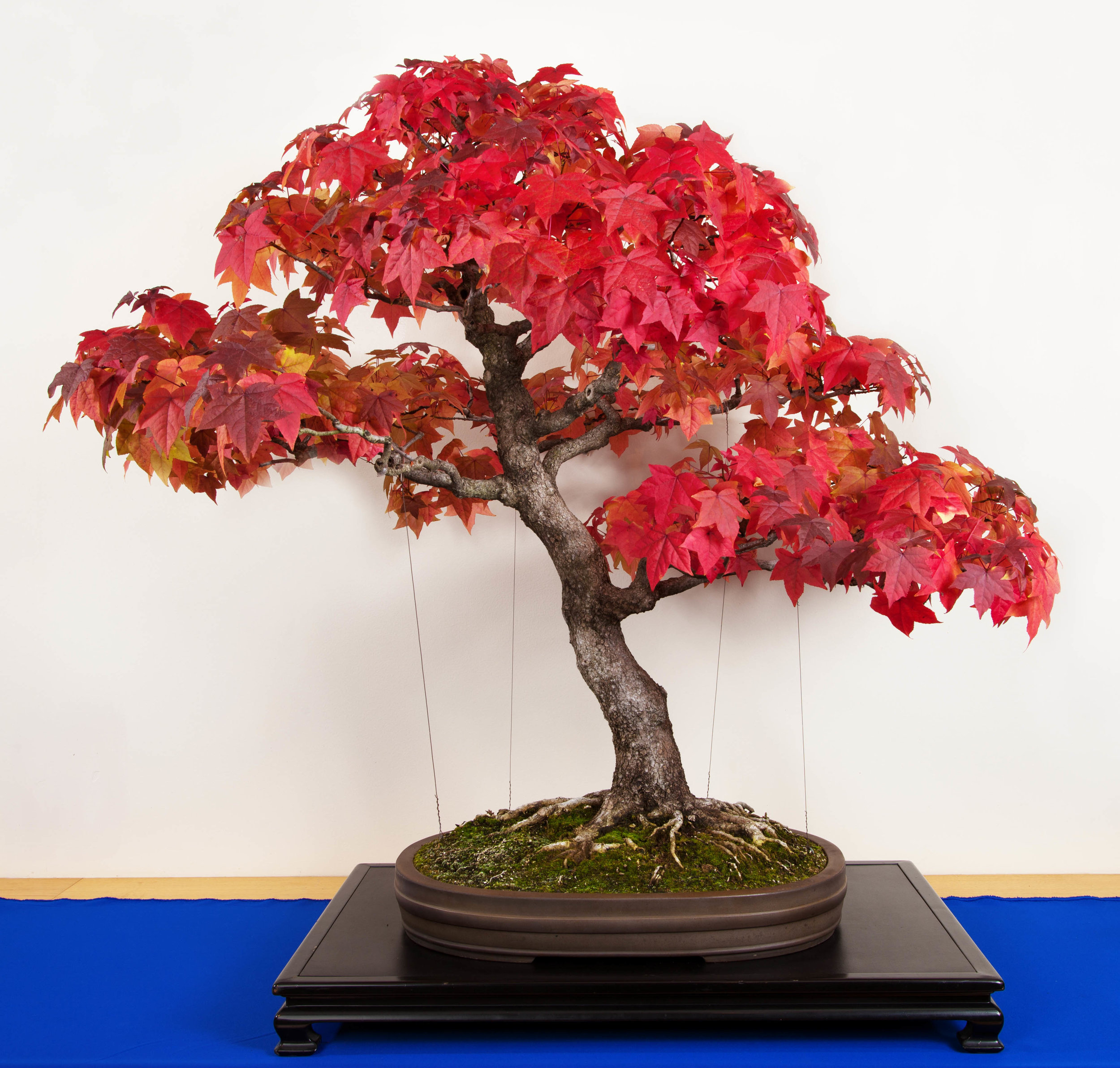
Sweetgum
Liquidambar styraciflua
In training since 1975
Gift of Vaughn Banting, 2003
This native sweetgum tree was collected in Louisiana and styled as a slanting bonsai. Its star-shaped leaves turn brilliant red in the fall.

Montezuma-cypress
Taxodium distichum var. mexicanum
In training since 1948
Gift of John Y. Naka, 2004
This was the first bonsai John created after moving to Los Angeles in 1946. He gave it to the museum right before he passed away at the age of 90.
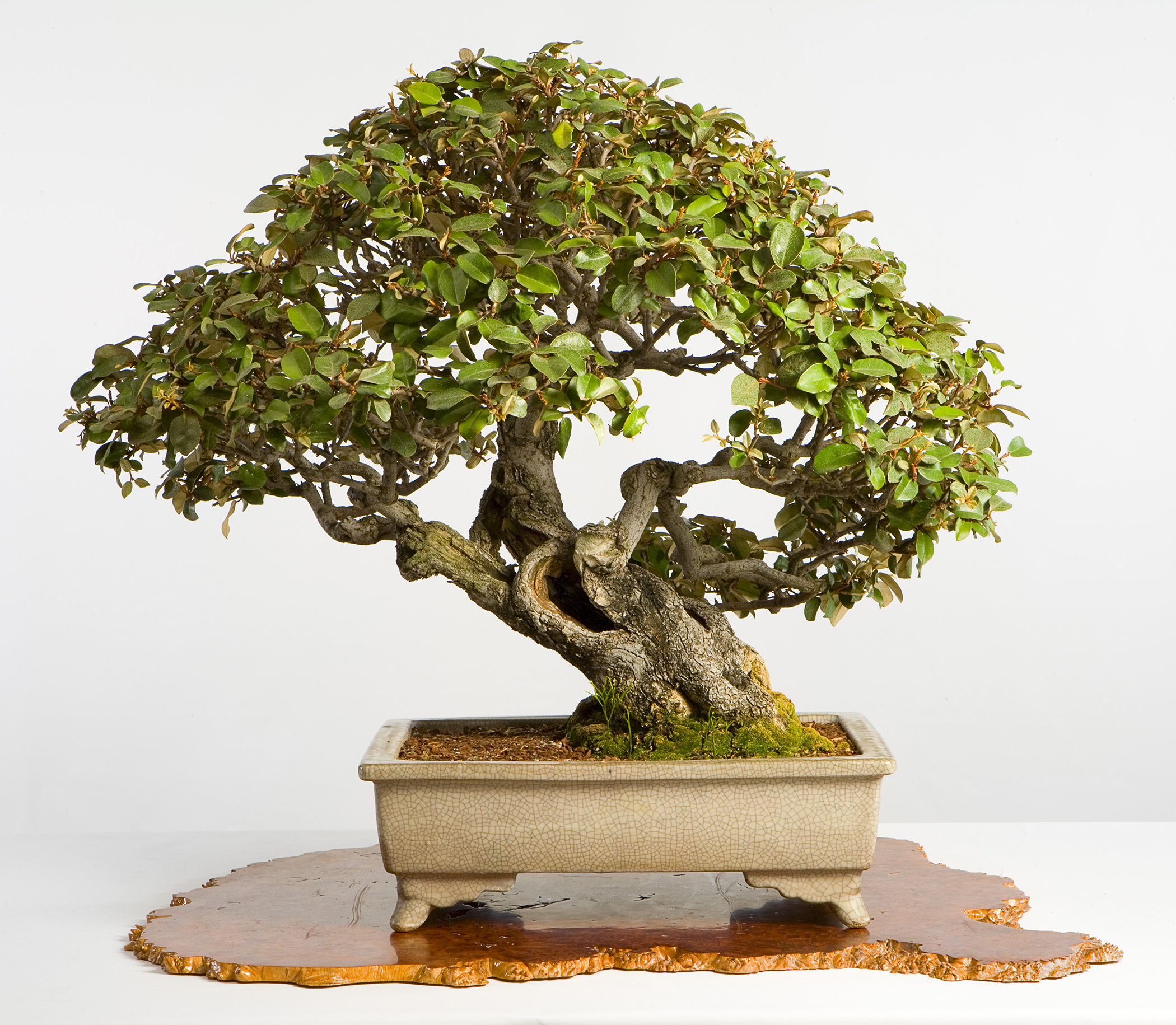
Thorny Elaeagnus
Elaeagnus pungens
In training since 1960
Gift of Mike Naka, 2004
The split and gnarly old trunk on this tree conveys the spirit of survival found in very old trees in nature. John Naka found this thorny elaeagnus growing on property to be demolished for freeway construction in southern California.
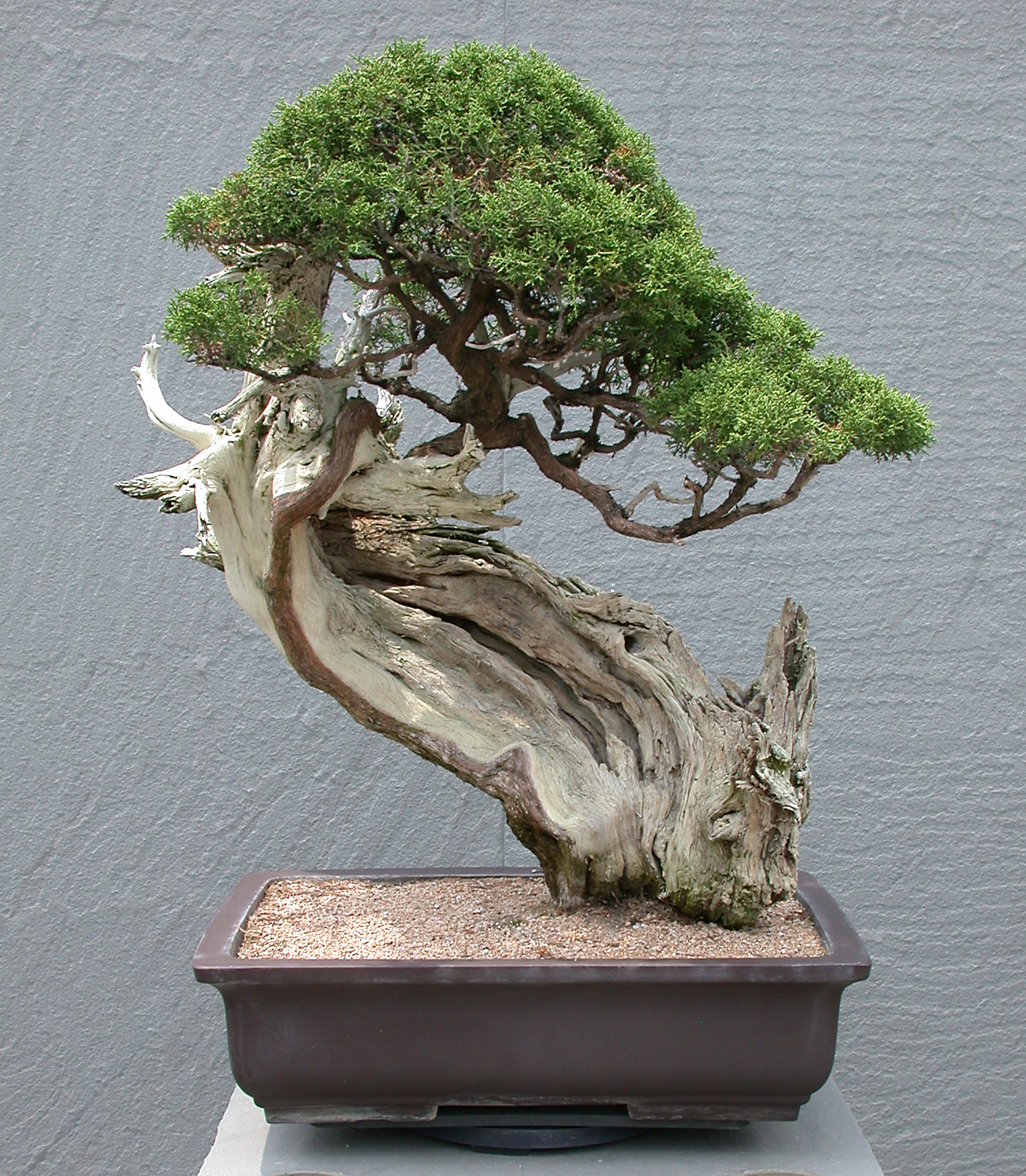
California Juniper
Juniperus californica
In training since 1964
Gift of Harry Hirao, 2004
Can you find the "lifeline" on this tree? It is the thin brown line hugging the underside of the deadwood trunk. This living tissue carries water from the roots to the foliage.
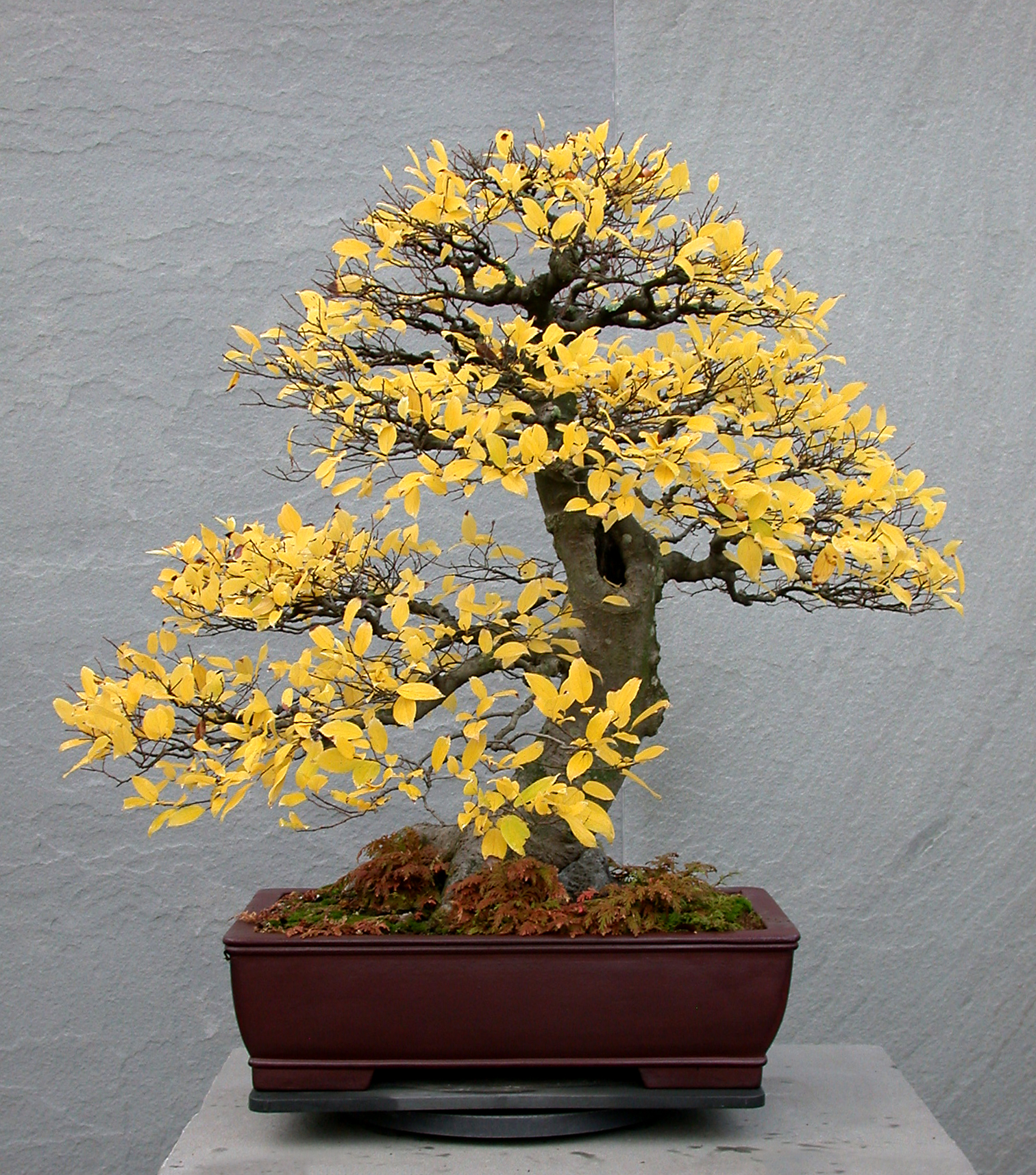
Chinese Hackberry
Celtis sinensis
In training since 1974
Gift of Dan Chiplis, 2004
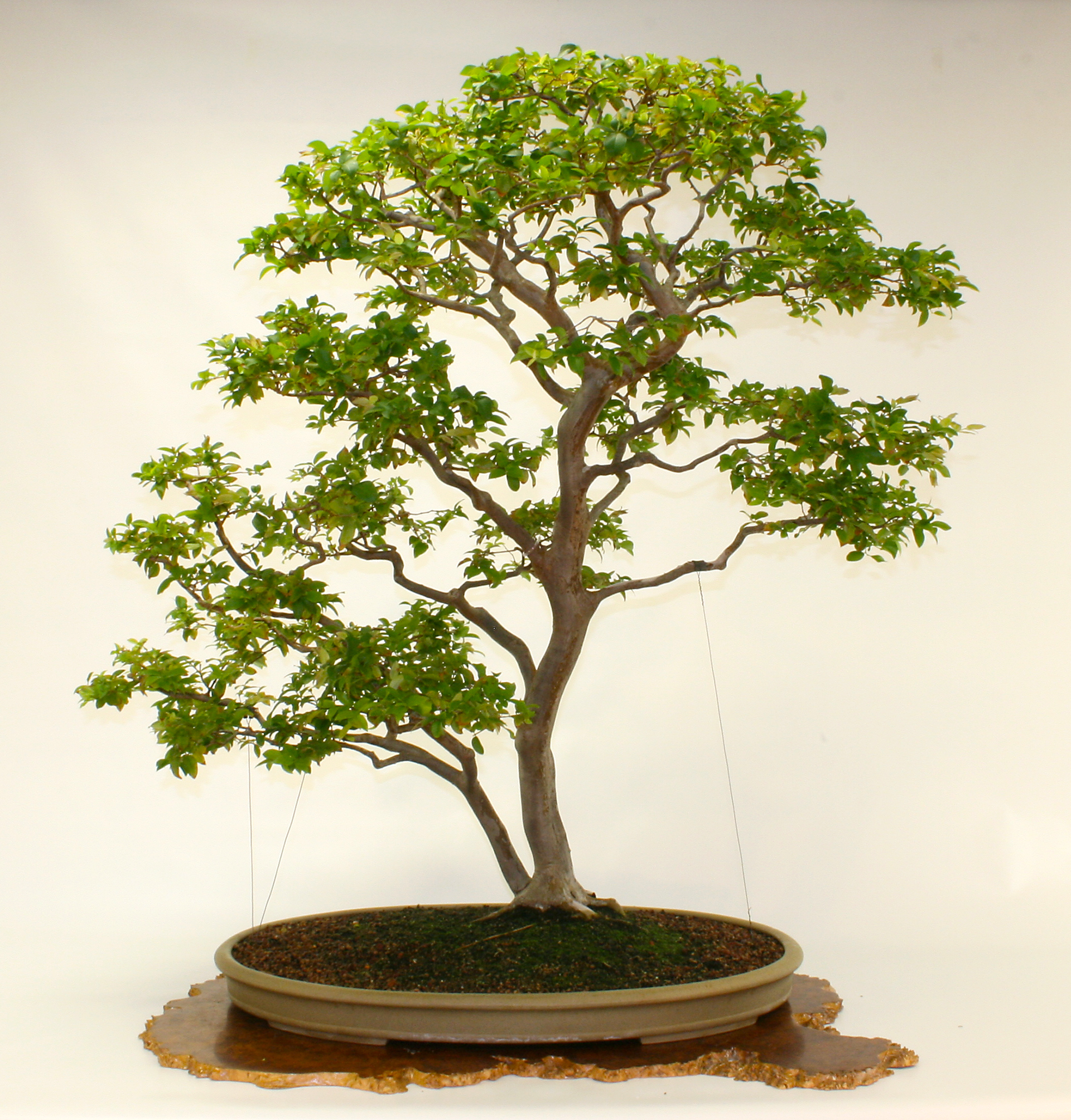
Jaboticaba
Myrciaria cauliflora
In training since 1970s
Gift of Edward & Jean Smith, 2009
This tropical species has become popular with bonsai artists for the beauty of its multicolored, sleek bark, revealed when the outer bark sheds each year.
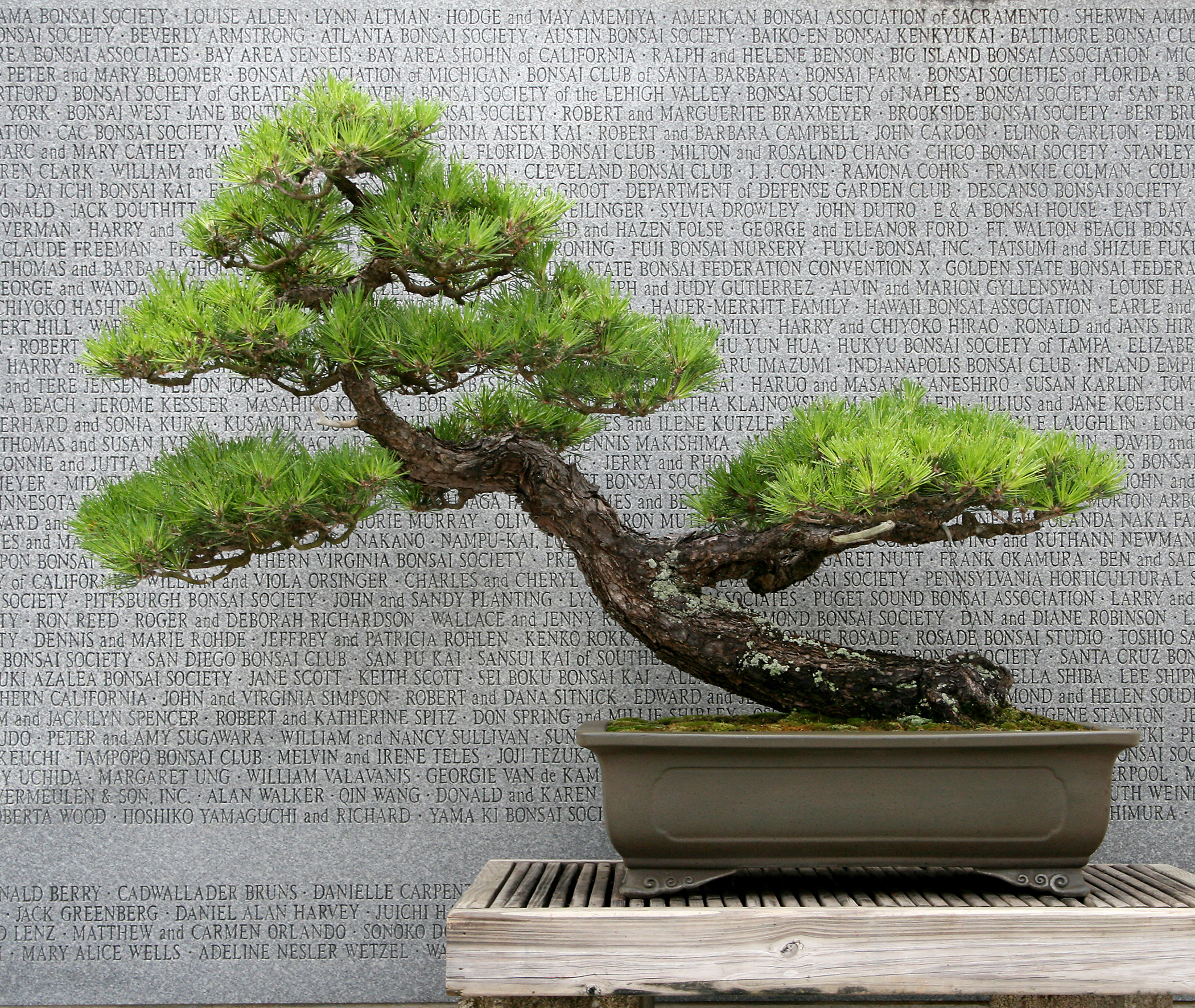
Japanese Black Pine
Pinus thunbergii
In training since 1980
Gift of Janet Lanman, 2010
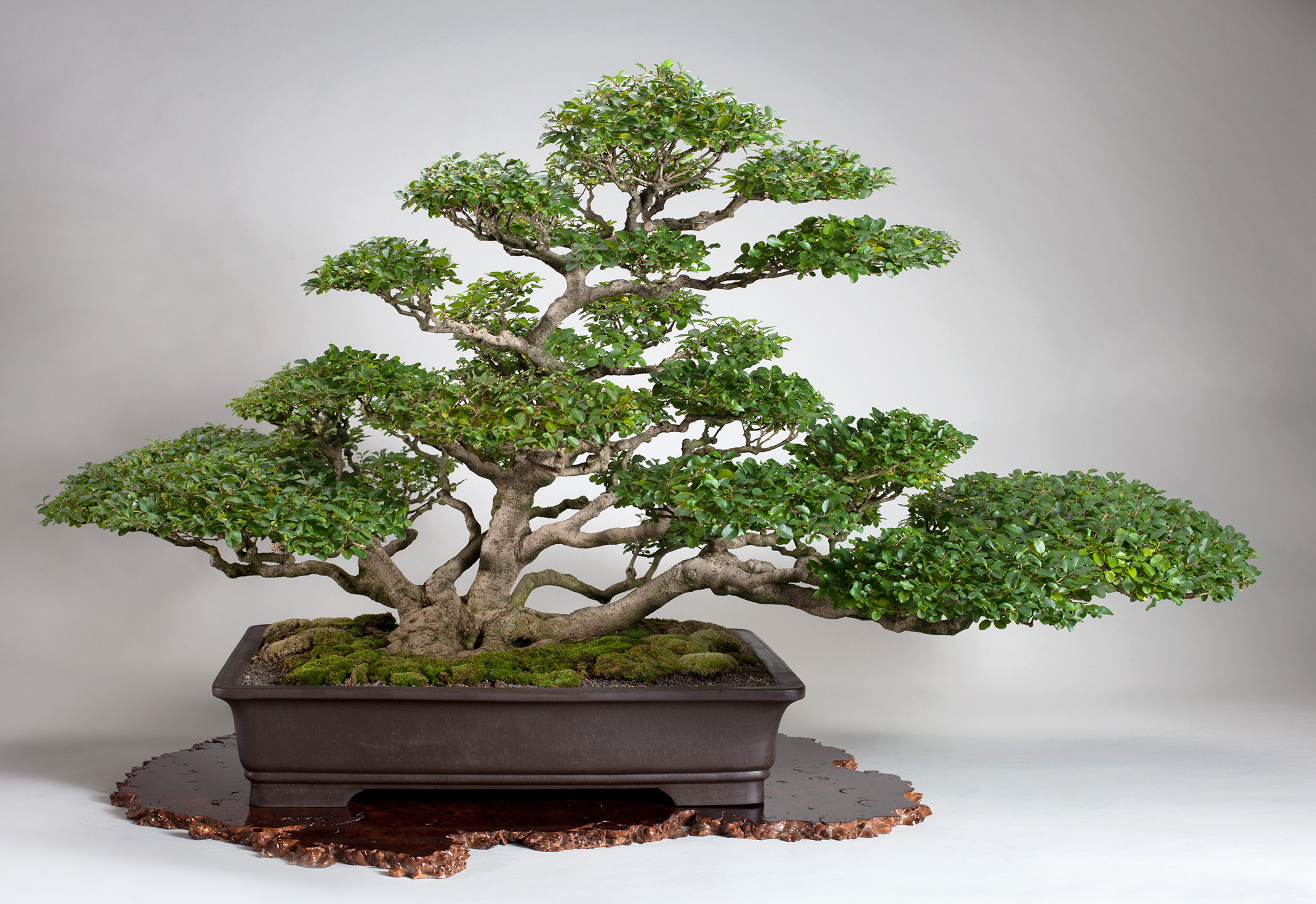
Common Privet
Ligustrum vulgare
In training since 1979
Gift of Jack Fried, 2010
Originally collected in a cow pasture, this privet was styled as a clump bonsai with a uniquely long lower branch.
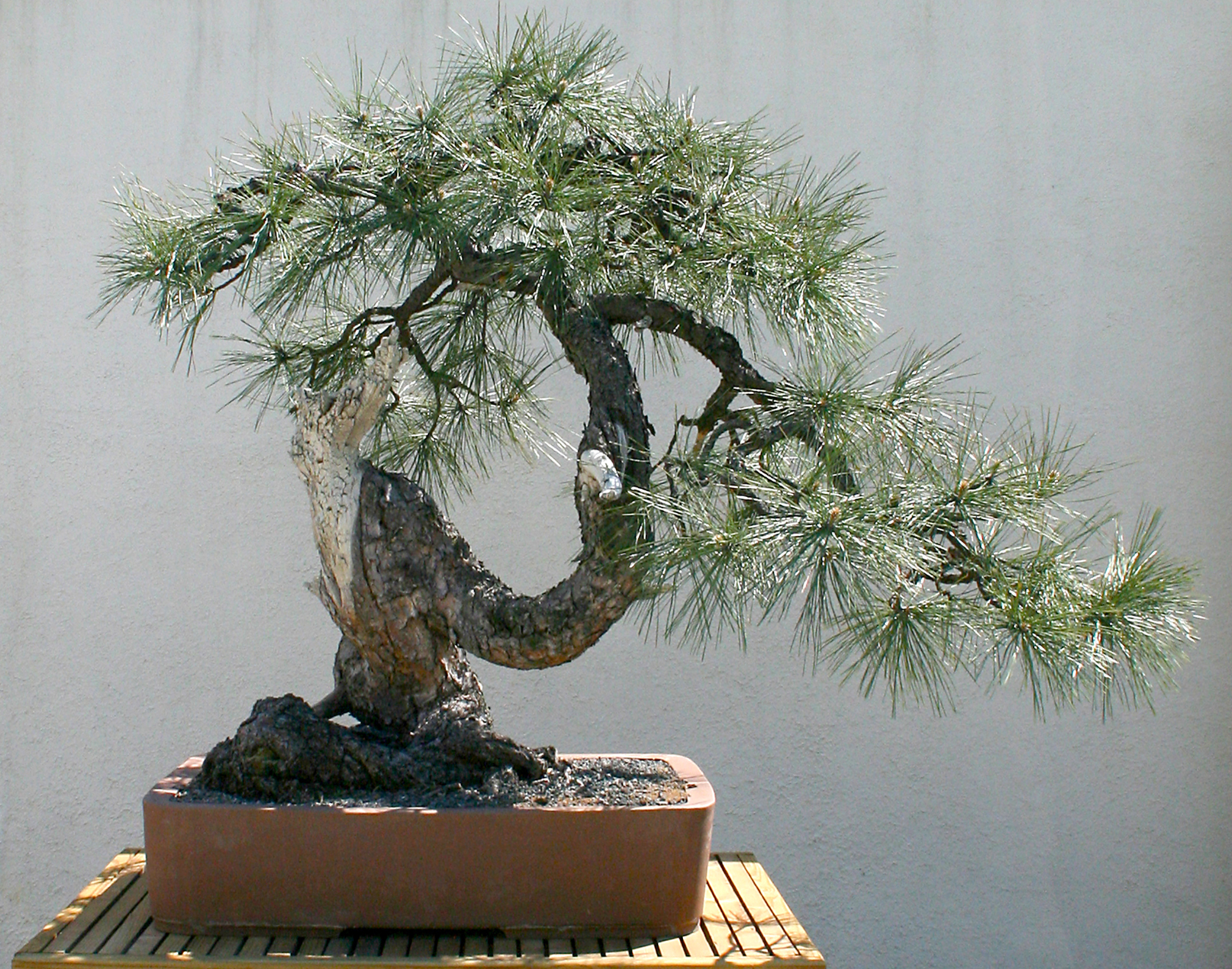
Ponderosa Pine
Pinus ponderosa
In training since 1966
Gift of the U.S. Forest Service, 1980
This ponderosa pine was donated to the museum in commemoration of the 75th anniversary of the Forest Service. It was collected and styled by Dan Robinson.
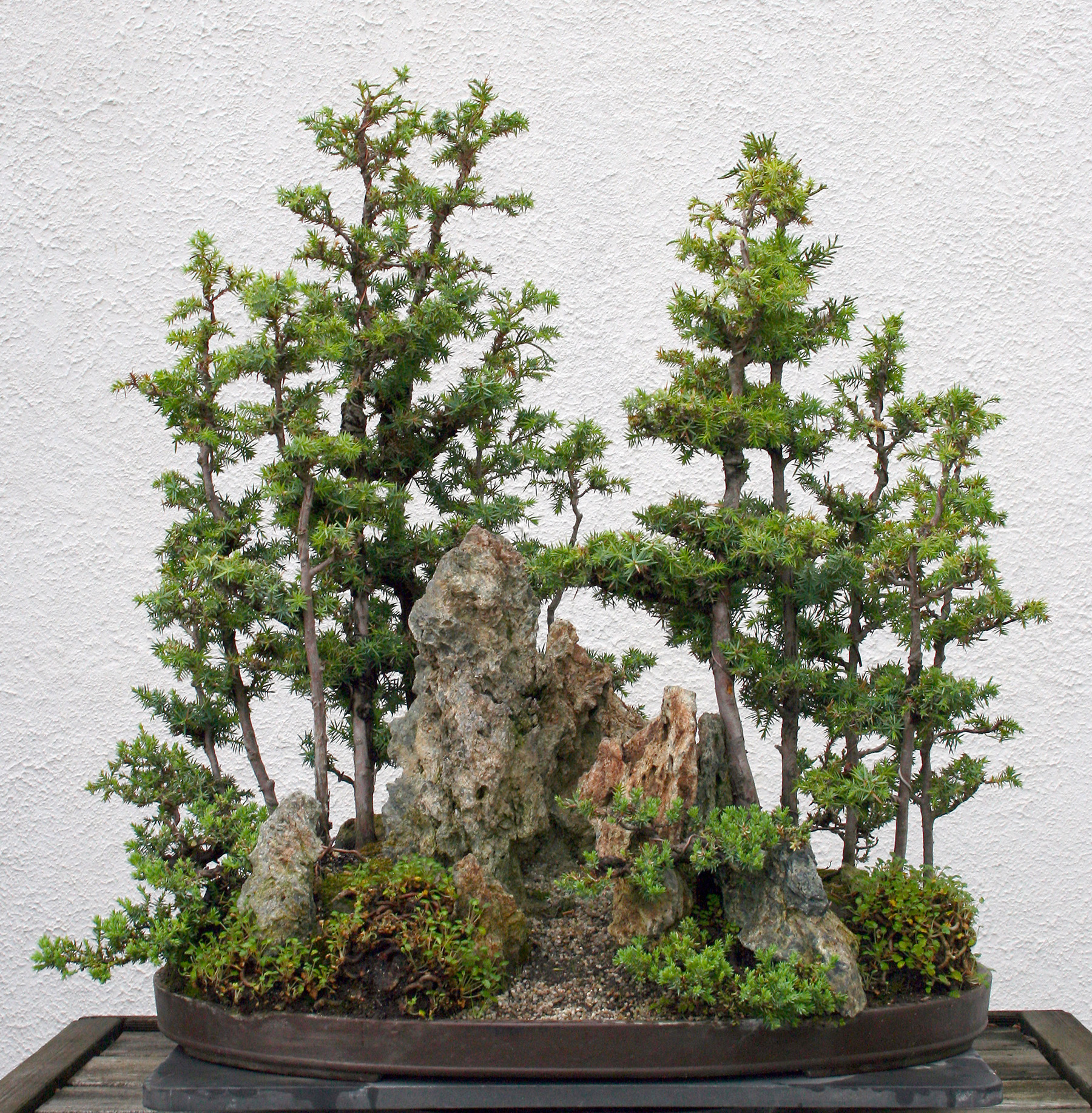
Juniper Saikei
Juniperus chinensis 'Femina' and Juniperus procumbens 'Nana'
In training since 2004
Gift of Frank Goya, 2012
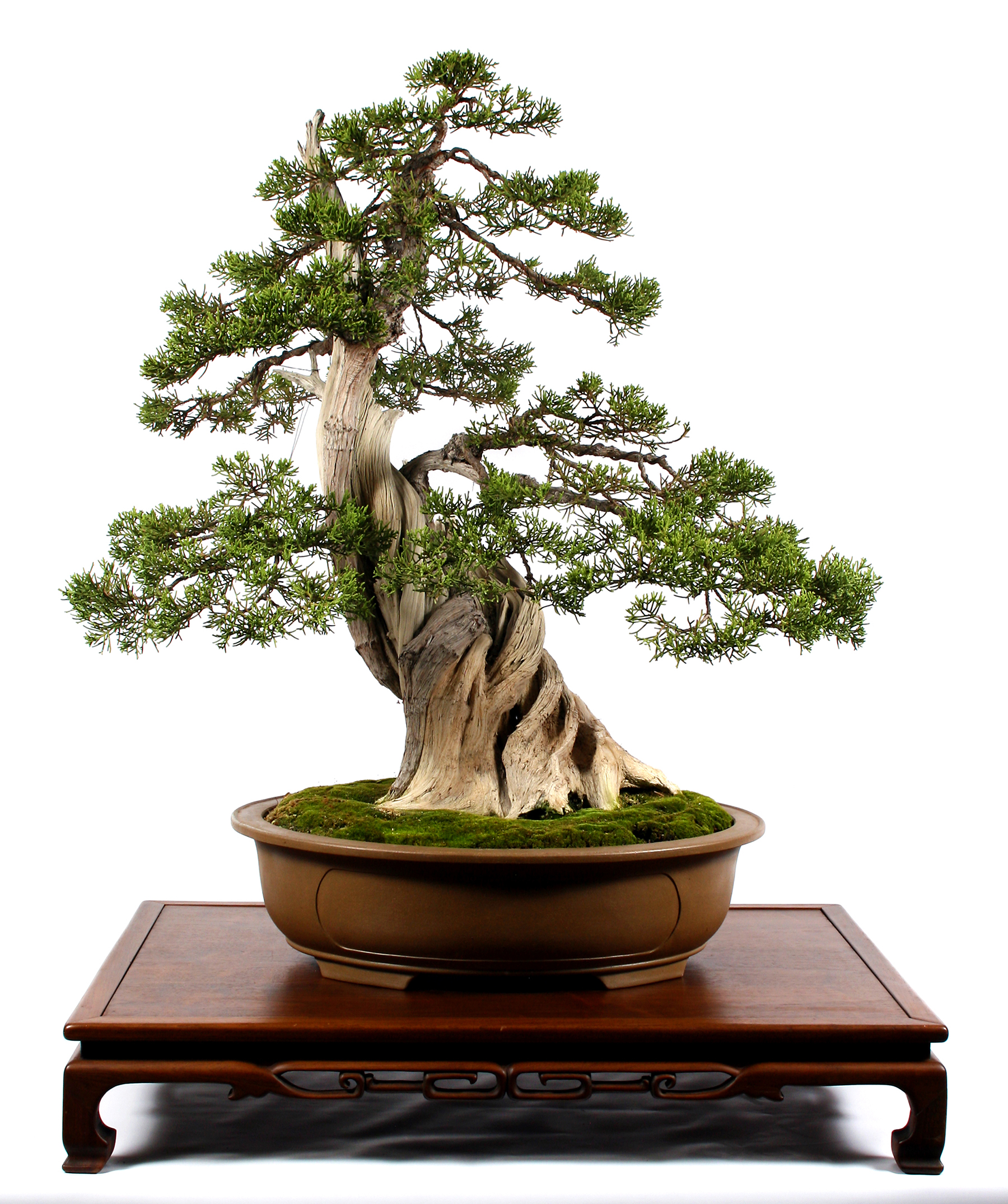
California Juniper
Juniperus californica
In training since 1982
Gift of Sze-ern Kuo, 2012
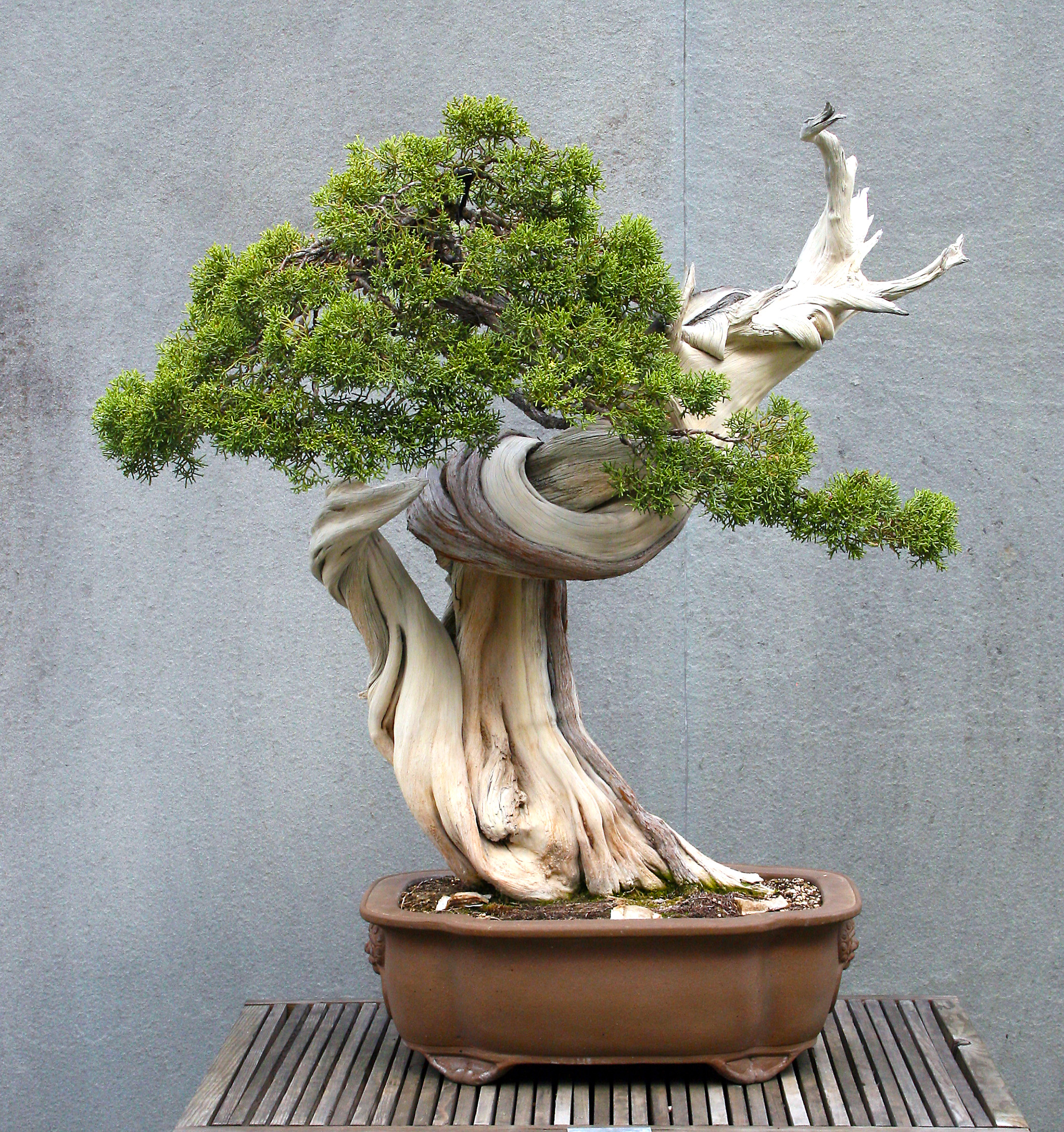
California Juniper
Juniperus californica
In training since 1989
Gift of Sze-ern Kuo, 2012
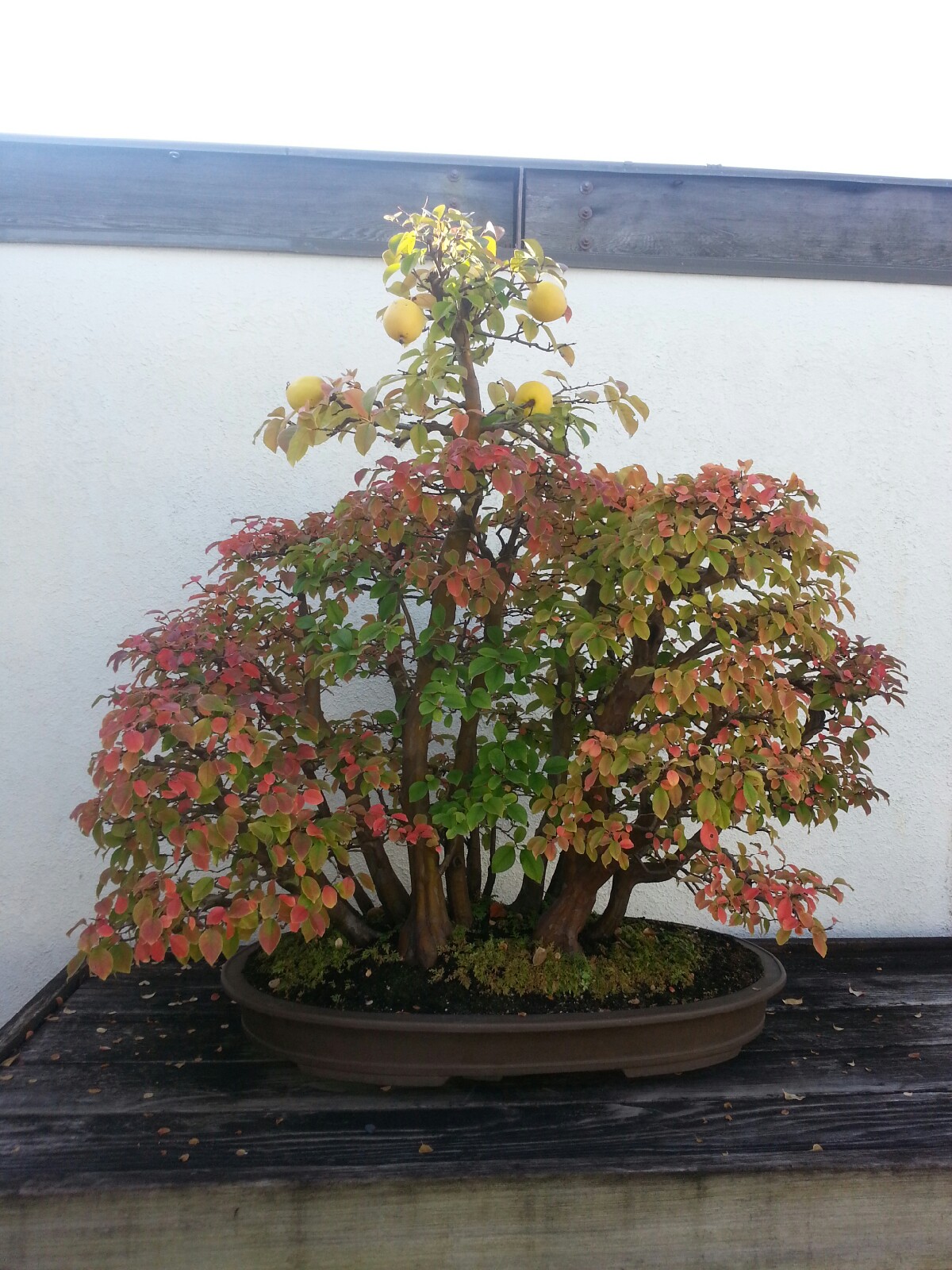
Chinese-quince
Pseudocydonia sinensis
In training since 1975
Gift of Warren Hill, 2013
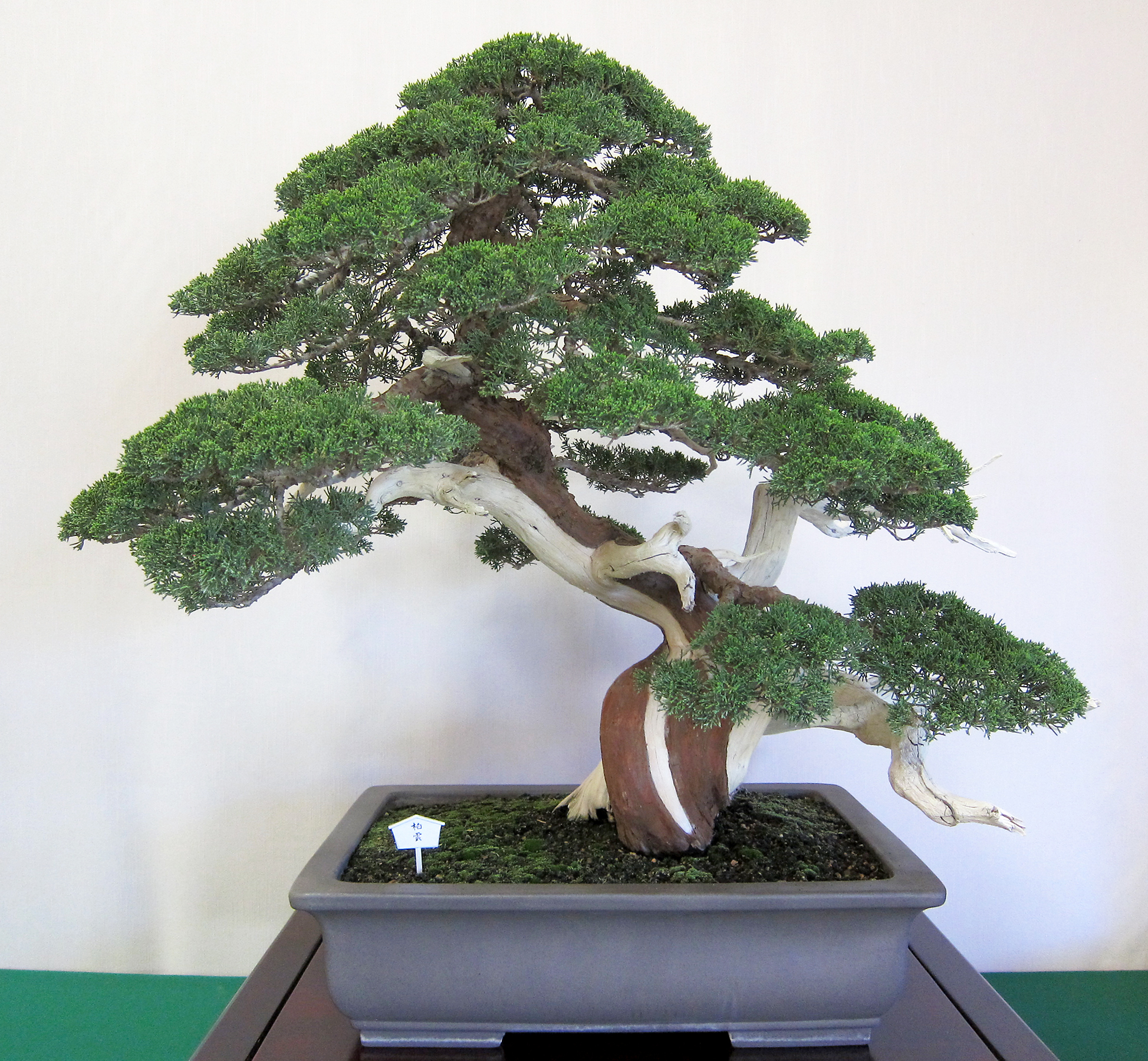
Chinese Juniper
Juniperus chinensis 'Itoigawa' (branches grafted onto Juniperus horizontalis 'Prostrata' trunk)
In training since 2006
Gift of Takashi Shimazu, 2015
This bonsai was formed by grafting branches of Juniperus chinensis 'Itoigawa' onto the trunk of a large Juniperus horizontalis 'Prostrata' collected at Kobata Nursery in South Gate, California.
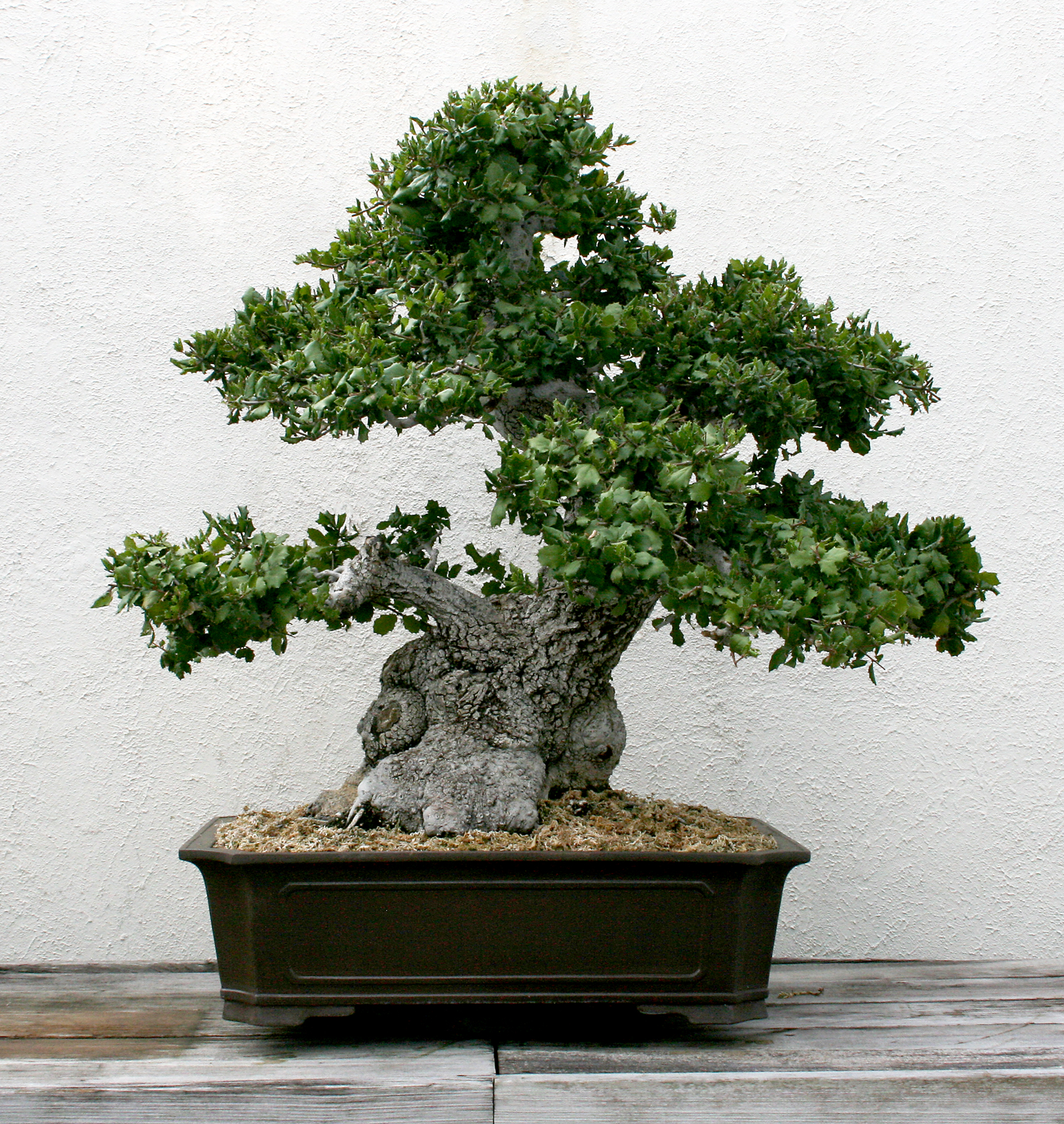
Coast Live Oak
Quercus agrifolia
In training since 1989
Gift of Al Nelson, 2016
Collected from a ranch in Santa Barbara, California.
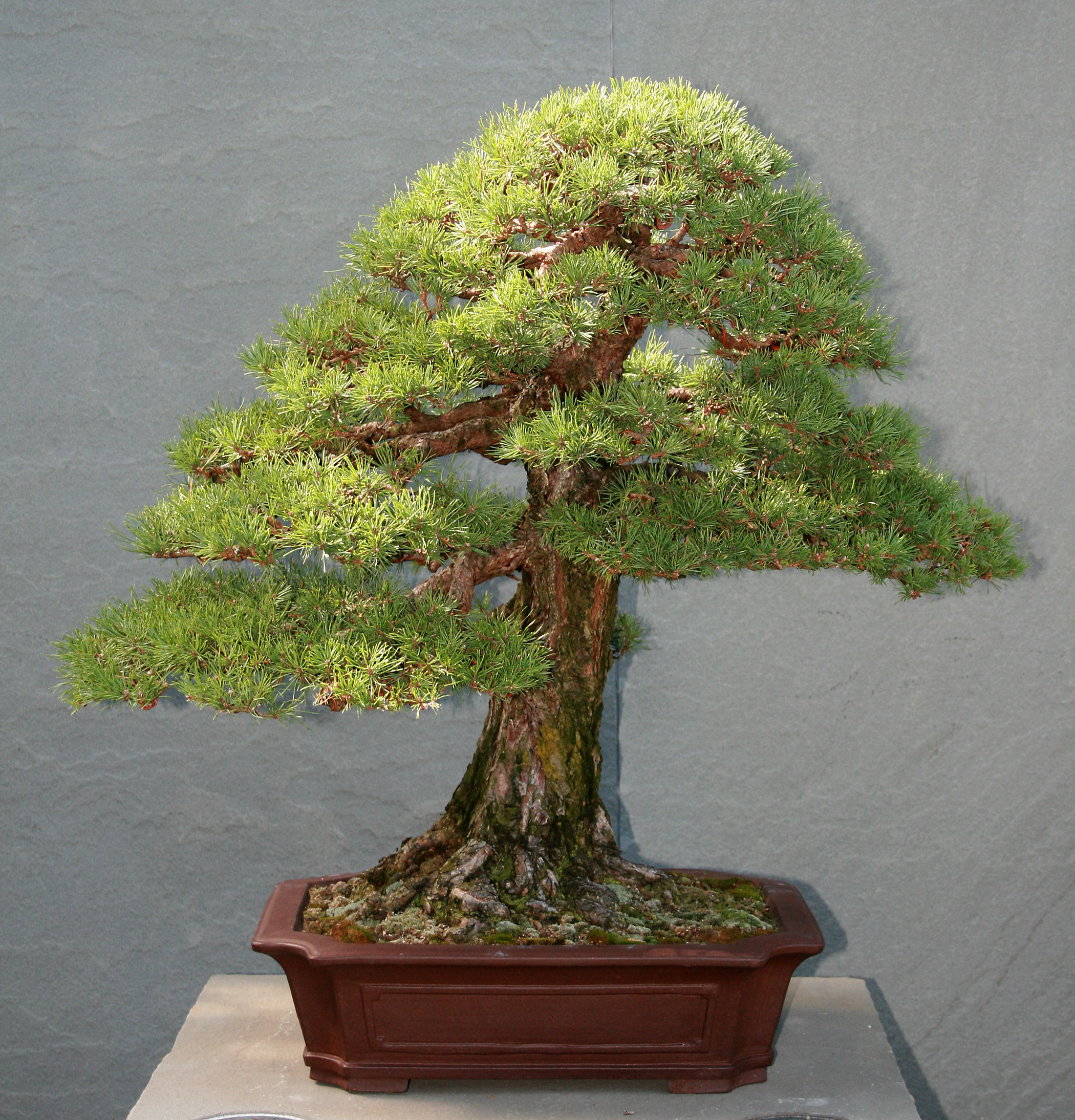
Scots Pine
Pinus sylvestris 'R.A.F.'
In training since 1980
Gift of William N. Valavanis, 2017
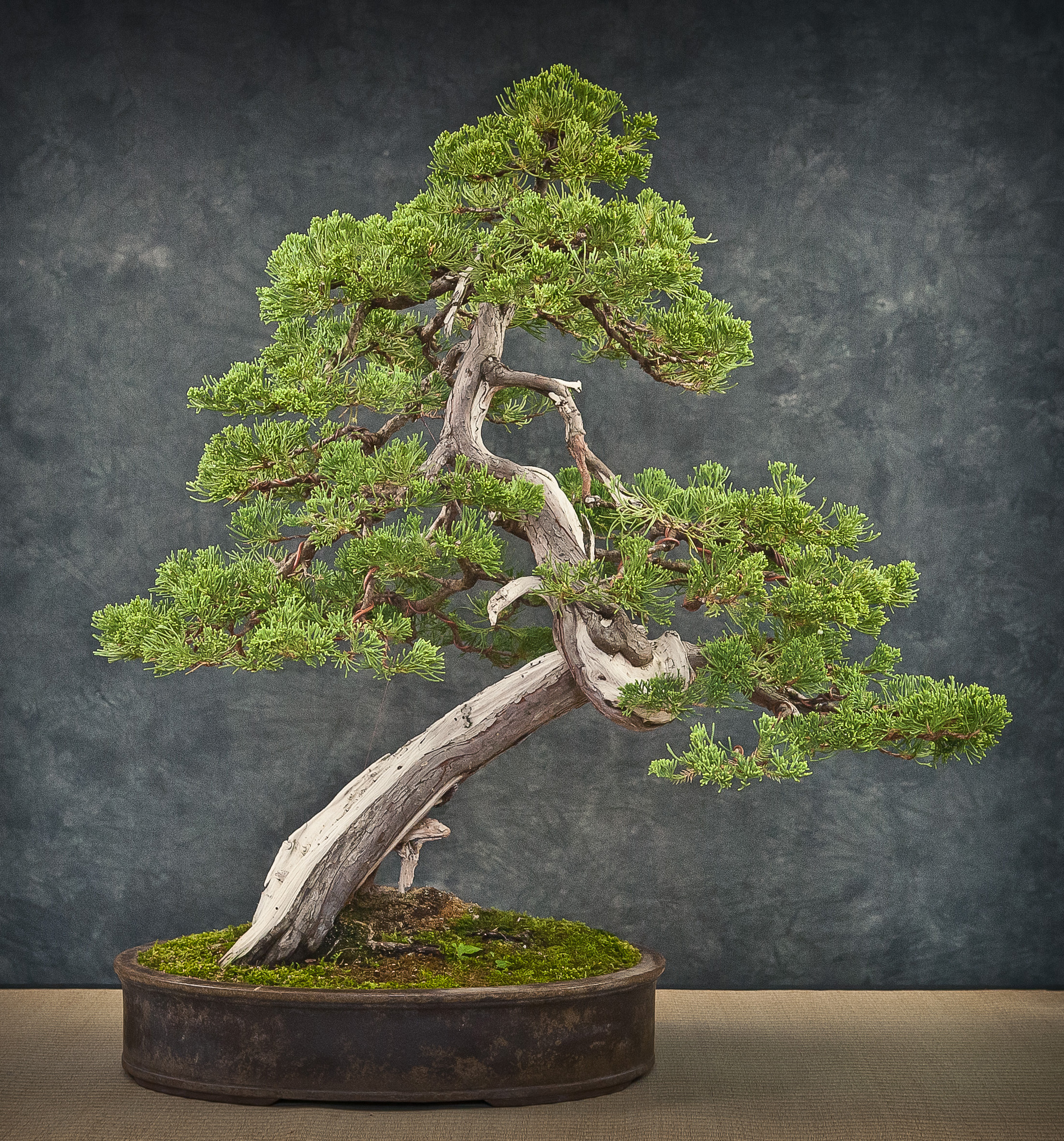
Prostrate Juniper
Juniperus horizontalis
In training since 1952
Gift of Sydney Porter, Jr., 2011
John Naka styled this bonsai and included it in his first book, Bonsai Techniques.































































